Falmec GRUPPO INCASSO 100, GRUPPO INCASSO 70, GRUPPO INCASSO 50, GRUPPO INCASSO 70 Murano, GRUPPO INCASSO 50 Murano INSTRUCTIONS BOOKLET
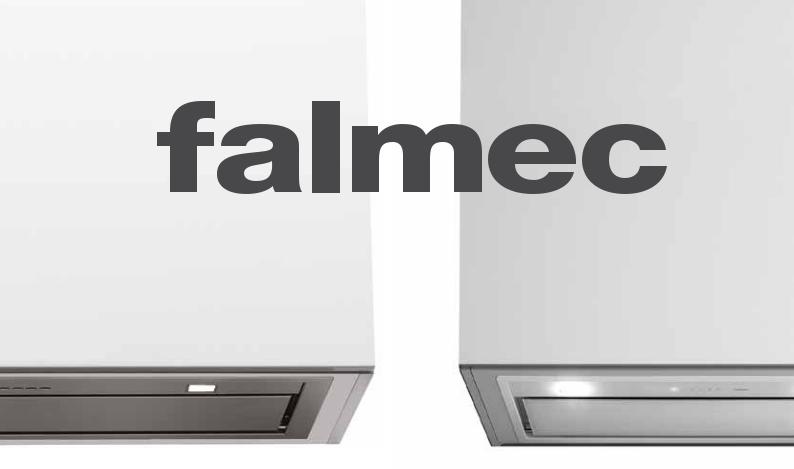
gruppo incasso gruppo incasso A+ gruppo incasso Murano
IT |
LIBRETTO ISTRUZIONI |
UK |
INSTRUCTIONS BOOKLET |
DE |
GEBRAUCHSANWEISUNG |
FR |
MODE D'EMPLOI |
ES |
MANUAL DE INSTRUCCIONES |
RU |
ИНСТРУКЦИИ |
PL |
INSTRUKCJA OBSŁUGI |
NL |
HANDLEIDING |
PT |
MANUAL DE INSTRUÇÕES |
DK |
BRUGSANIVSNINGER |
SE |
INSTRUKTIONSBOK |
FI |
OHJEKIRJA |
NO |
BRUKSANVISNING |
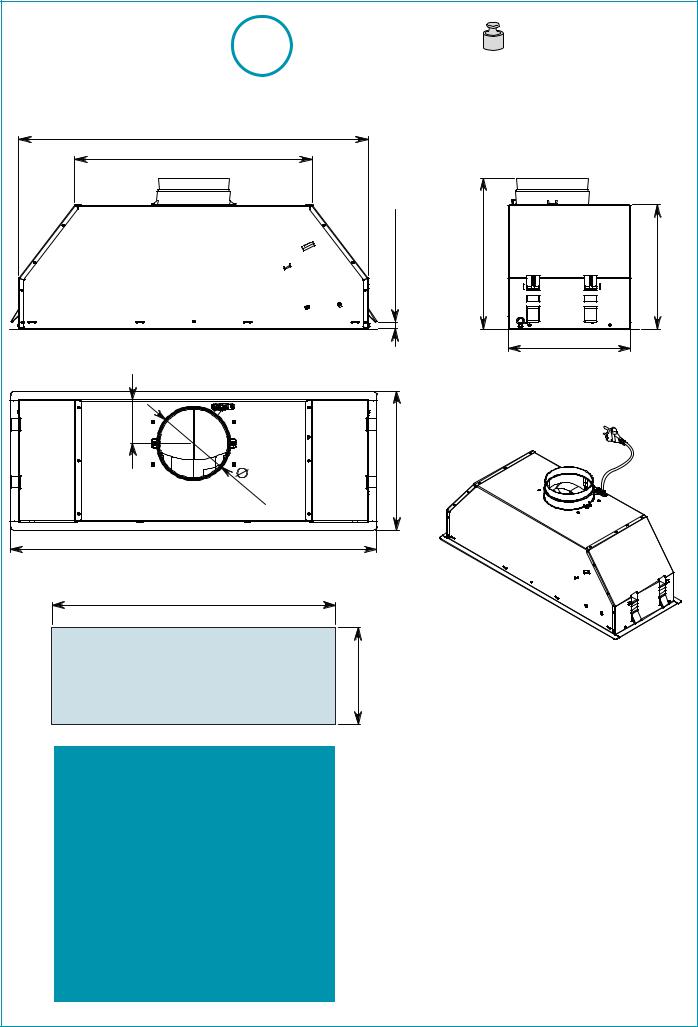
GRUPPO INCASSO 100 |
800 |
|
GRUPPO INCASSO |
70 |
|
GRUPPO INCASSO |
50 |
m3/h |
|
||
GRUPPO INCASSO |
70 Murano |
|
GRUPPO INCASSO |
50 Murano |
|
|
1017 / 739 / 494 |
|
|
780 / 502 / 257 |
|
<![endif]>93
150
1053 / 776 / 531
1029 / 751 / 506
<![if ! IE]><![endif]>262
IT - MISURE FORO PER INCASSO
UK - HOLE MEASUREMENTS FOR INSTALLATION
DE - LOCHABMESSUNGEN FÜR EINBAU
FR - MESURES DU TROU POUR ENCASTREMENT
ES - MEDIDAS DEL ORIFICIO PARA EMPOTRADO
RU - РАЗМЕРЫ МОНТАЖНОГО ОТВЕРСТИЯ
PL - WYMIARY OTWORU DO ZABUDOWY
NL - MATEN GAT VOOR INBOUW
PT - MEDIDAS DO FURO PARA EMBUTIR
DK - MÅL TIL ÅBNING FOR INDBYGNING
SE - MÅTT HÅL FÖR INBYGGNAD
FI - AUKON MITAT UPOTUSTA VARTEN
NOHULLMÅL FOR INNFELLING
Gruppo incasso 100: 15 kg
Gruppo incasso |
70: 12 kg |
|
Gruppo incasso |
50: 10 kg |
|
Gruppo incasso Murano |
70: |
13 kg |
Gruppo incasso Murano |
50: |
11 kg |
| <![if ! IE]> <![endif]>min 12/max 20 |
<![if ! IE]> <![endif]>319 |
<![if ! IE]> <![endif]>263 |
|
|
259 |
<![endif]>294
2
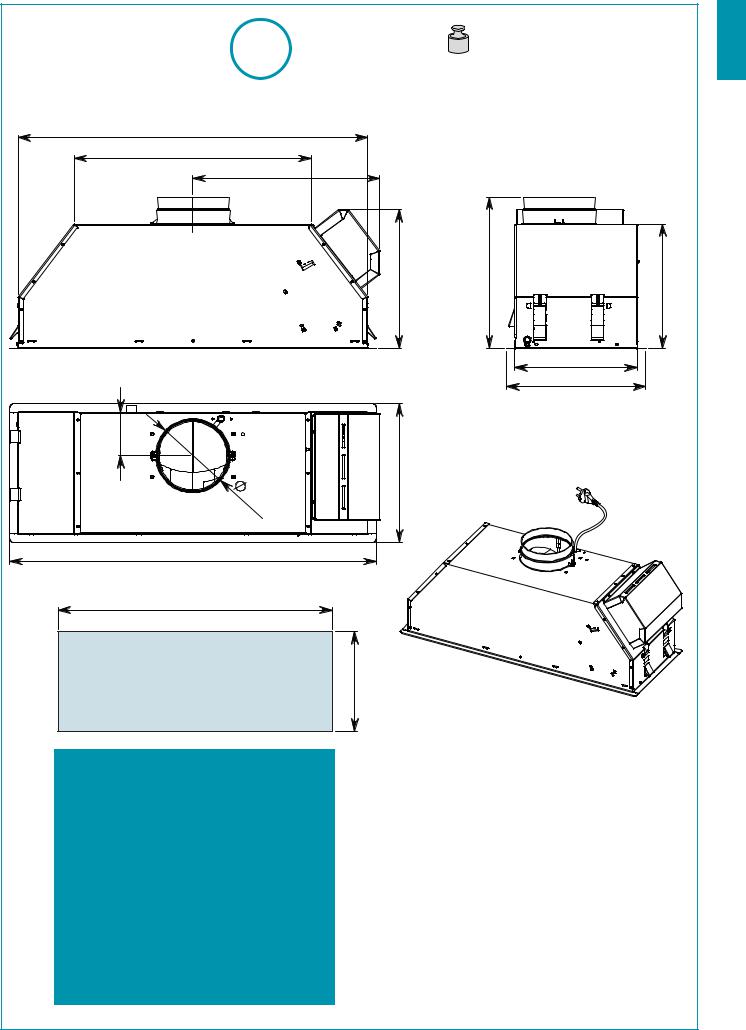
GRUPPO INCASSO A+ |
70 |
800 |
Gruppo incasso A+ 70: |
13 kg |
GRUPPO INCASSO A+ |
50 |
Gruppo incasso A+ 50: |
11 kg |
|
|
|
m3/h |
|
|
739 / 494
502 / 257
396 / 273
| <![if ! IE]> <![endif]>293 |
<![if ! IE]> <![endif]>319 |
<![if ! IE]> <![endif]>263 |
259
294
<![if ! IE]><![endif]>93
<![if ! IE]><![endif]>294
150
776 / 631
751 / 506
<![if ! IE]><![endif]>262
IT - MISURE FORO PER INCASSO
UK - HOLE MEASUREMENTS FOR INSTALLATION
DE - LOCHABMESSUNGEN FÜR EINBAU
FR - MESURES DU TROU POUR ENCASTREMENT
ES - MEDIDAS DEL ORIFICIO PARA EMPOTRADO
RU - РАЗМЕРЫ МОНТАЖНОГО ОТВЕРСТИЯ
PL - WYMIARY OTWORU DO ZABUDOWY
NL - MATEN GAT VOOR INBOUW
PT - MEDIDAS DO FURO PARA EMBUTIR
DK - MÅL TIL ÅBNING FOR INDBYGNING
SE - MÅTT HÅL FÖR INBYGGNAD
FI - AUKON MITAT UPOTUSTA VARTEN
NOHULLMÅL FOR INNFELLING
<![endif]>ITALIANO
3
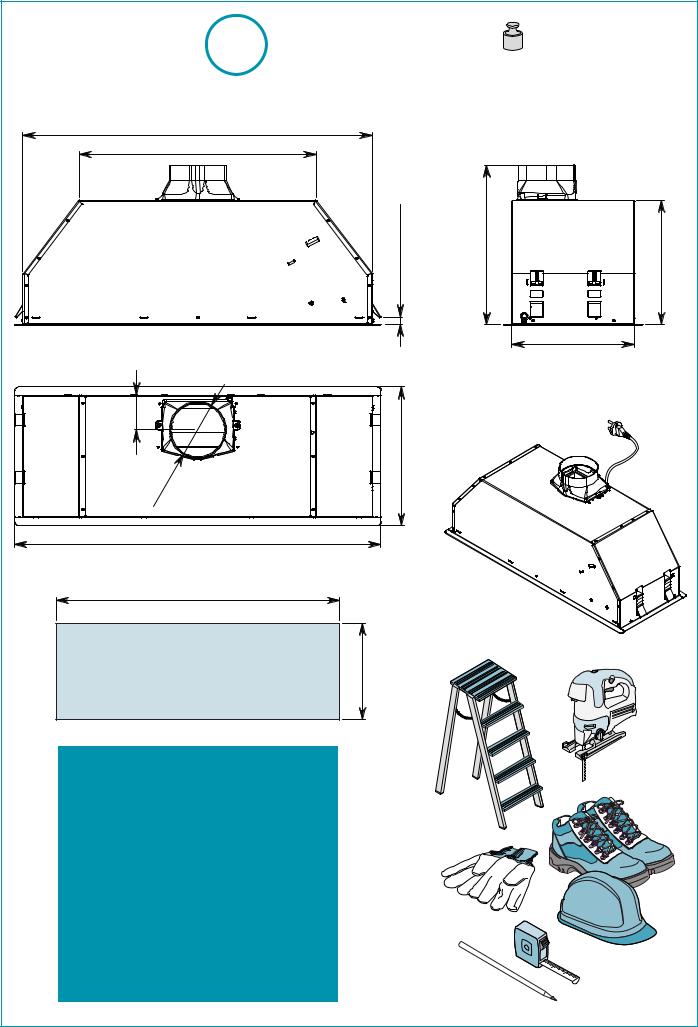
GRUPPO INCASSO 70 |
600 |
Gruppo incasso 70: |
12 kg |
GRUPPO INCASSO 50 |
Gruppo incasso 50: |
10 kg |
|
|
m3/h |
|
|
739 / 494
| <![if ! IE]> <![endif]>min 12/max 20 |
<![if ! IE]> <![endif]>337 |
<![if ! IE]> <![endif]>263 |
|
|
259 |
<![endif]>74
 120
120
776 / 531
751 / 506
<![endif]>294
<![if ! IE]><![endif]>262
IT - MISURE FORO PER INCASSO
UK - HOLE MEASUREMENTS FOR INSTALLATION DE - LOCHABMESSUNGEN FÜR EINBAU
FR - MESURES DU TROU POUR ENCASTREMENT ES - MEDIDAS DEL ORIFICIO PARA EMPOTRADO RU - РАЗМЕРЫ МОНТАЖНОГО ОТВЕРСТИЯ
PL - WYMIARY OTWORU DO ZABUDOWY NL - MATEN GAT VOOR INBOUW
PT - MEDIDAS DO FURO PARA EMBUTIR DK - MÅL TIL ÅBNING FOR INDBYGNING SE - MÅTT HÅL FÖR INBYGGNAD
FI - AUKON MITAT UPOTUSTA VARTEN NOHULLMÅL FOR INNFELLING
4
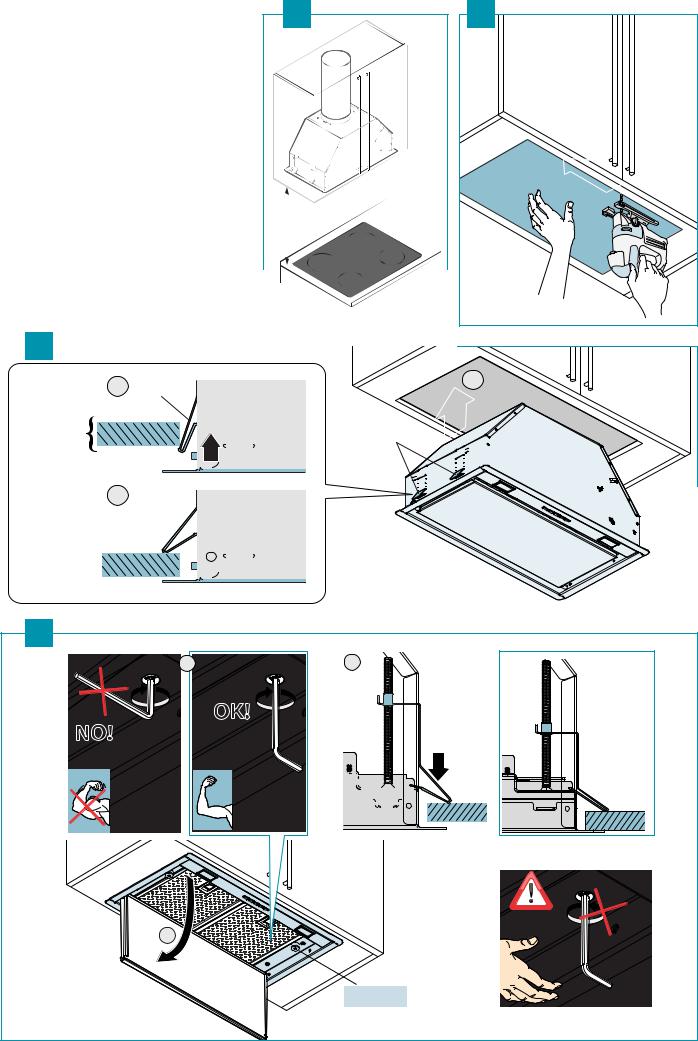
IT |
- Misure installazione (1), foratura pensile (2), |
1 |
2 |
|
|
inserimento cappa (3), issaggio al pensile (4) |
|
|
|
UK |
- Installation measurements (1), wall unit hole (2), |
|
|
|
|
hood installation (3), itting to the wall unit (4) |
|
|
|
DE |
- Installationsabmessungen (1), Bohrung Hängekasten (2), |
|
|
|
|
Einfügen der Abzugshaube (3), Befestigung am Hängekasten (4) |
|
|
|
FR |
- Mesures pour installation (1), perçage meuble (2), |
|
|
|
|
mise en place de la hotte (3), ixation au meuble (4) |
|
|
|
ES |
- Medidas instalación (1), oriicio armario de pared (2), |
|
|
|
|
introducción campana (3), ijación en el armario de pared (4) |
|
|
|
RU |
- Монтажные размеры (1), выполнение отверстия в навесном шкафу |
|
|
|
|
(2), монтаж вытяжки (3), крепление к навесному шкафу (4) |
|
|
|
PL |
- Wymiary instalacji (1), nawiercenie szafki wiszącej (2), |
|
|
|
|
wsunięcie okapu (3), mocowanie do szafki wiszącej (4) |
|
|
|
NL |
- Installatiematen (1), opening keukenkastje (2), |
|
|
|
|
plaatsing kap (3), bevestiging aan het keukenkastje (4) |
|
|
|
PT |
- Medidas para a instalação (1), perfuração de elemento suspen- |
620 |
|
|
|
so (2), inserção da coifa (3) e ixação ao elemento suspenso (4) |
|
||
DK |
- Installationsmål (1), hul i skab (2), |
mm |
|
|
|
|
|||
|
Isætning af emhætten (3), fastgørelse til skab (4) |
|
|
|
SE |
- Mått installation (1), hål skåp (2), |
|
|
|
|
insättning av kåpa (3), fastsättning i skåpet (4) |
|
|
|
FI |
- Asennusmitat (1), hyllyn aukon teko (2), |
|
|
|
|
liesituulettimen paikalleen asetus (3), kiinnitys hyllyyn (4) |
|
|
|
NO |
- Installasjonsmål (1), boring i veggskap (2), |
|
|
|
|
innsetting av ventilatorhette (3), festing til veggskap (4) |
|
|
|
|
3 |
|
|
|
|
2 |
MO |
|
1 |
|
|
|
||
|
|
|
|
|
|
Max 20 mm |
|
|
MO |
|
Min 12 mm |
|
|
|
3 |
|
|
|
4 |
|
|
|
V1 (x4) |
2 |
V1 (x4) |
3 |
|
|
||
NO! |
|
OK! |
|
|
|
|
|
|
|
|
V1 (x4) |
|
|
|
Only for |
1 |
|
|
maint. |
|
|
|
|
|
|
|
MAGNET |
|
|
|
5 |
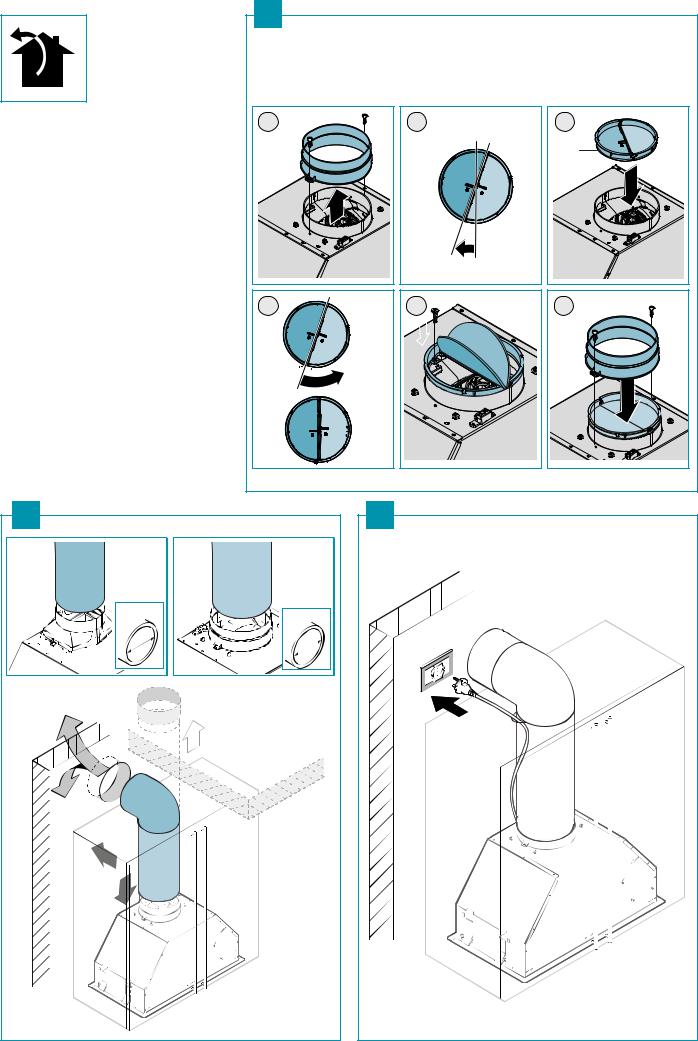
|
|
|
|
5 |
|
|
|
|
|
|
|
Only for |
800 |
|
|
|
|
|
|
|
|
m3/h |
|
IT |
- Installazione valvola di non ritorno (5), tubo |
1 |
|
2 |
3 |
||
|
di aspirazione (6) e collegamento elettrico (7) |
|
|
|
|
||
UK |
- Installation of check valve (5), suction pipe (6) |
|
ERM |
|
M |
||
|
and electrical connection (7) |
|
|
|
|
||
|
|
|
|
|
|
||
DE |
- Installation des Rückschlagventils (5), des Absaug- |
|
|
|
|
||
|
rohrs (6) und der elektrischen Verbindung (7) |
|
|
|
|
|
|
FR |
- Installation clapet de non retour (5), tuyau |
|
|
|
|
|
|
|
d'aspiration (6) et branchement électrique (7) |
|
|
|
|
||
ES |
- Instalación de la válvula de no-retorno (5), |
|
|
|
|
|
|
|
tubo de aspiración (6) y conexión eléctrica (7) |
|
|
|
|
||
RU |
- Установка обратного клапана (5), вытяжная |
|
|
|
|
|
|
|
труба (6) подключение к электрической сети (7) |
|
|
|
|
||
PL |
- Instalacja zaworu zwrotnego (5), przewodu |
|
|
|
|
|
|
|
zasysającego (6) i podłączenia elektrycznego (7) |
4 |
|
5 |
6 |
||
NL |
- Installatie keerklep (5), afzuigbuis (6) en |
|
|
||||
|
|
|
|
|
|||
|
elektrische aansluiting (7) |
|
|
|
|
|
|
PT |
- Instalação da válvula de não retorno (5), tubo |
|
|
|
ERM |
||
|
de aspiração (6) e ligação elétrica (7) |
|
|
|
|
||
|
|
|
|
|
|
||
DK |
- Installation af kontraventil (5), rør til udsug |
|
|
|
|
|
|
|
(6) og elektrisk tilslutning (7) |
|
|
|
|
|
|
SE |
- Installation av backventil (5), utsugningsrör |
|
|
|
|
||
|
(6) samt elektrisk anslutning (7) |
|
|
|
|
|
|
FI |
- Vastaventtiilin (5) asennus, imuputki (6) ja |
|
|
|
|
|
|
|
sähköliitäntä (7) |
|
|
|
|
|
|
NO - Installasjon av tilbakeslagsventil (5), innsu- |
|
|
|
|
|
||
|
gingsrør (6) og elektrisk tilkobling (7) |
|
|
|
|
|
|
|
6 |
|
|
|
|
7 |
|
|
|
600 |
|
|
800 |
|
|
|
ø 12 |
m3/h |
ø 15 |
|
m3/h |
|
|
|
|
|
|
|
|
||
|
|
122mm |
|
|
150mm |
|
|
|
|
|
|
|
|
|
|
6
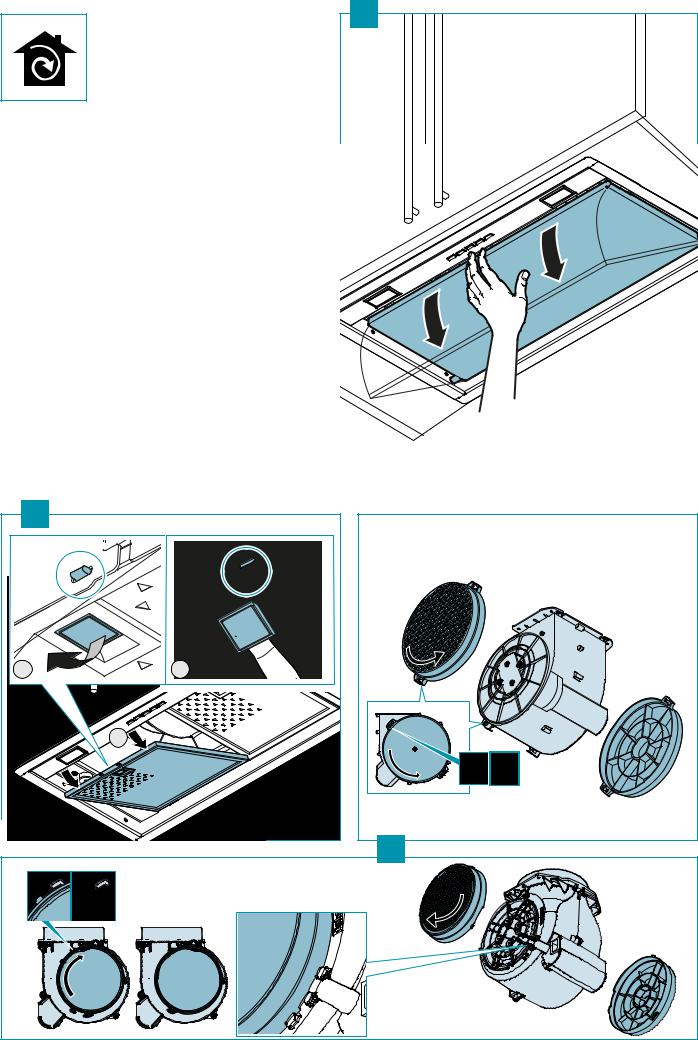
8
IT |
- Montaggio iltro carbone attivo di serie: rimuovere pannello (8), |
|
rimuovere iltri metallici (9), montare iltri carbone attivo (10). |
EN |
- Assembling standard active carbon ilter: remove panel (8), remove |
|
metal ilters (9), assemble active carbon ilters (10). |
DE |
- Montage des standardmäßigen Aktivkohleilters: Platte entfernen |
|
(8), Metallilter entfernen (9), Aktivkohleilter montieren (10). |
FR |
- Montage iltre au charbon actif standard : déposer le panneau (8), reti- |
|
rer les iltres métalliques (9), monter les iltres au charbon actif (20). |
ES |
- Montaje del iltro de carbón activo de serie: quite el panel (8), quite |
|
los iltros metálicos (9), monte los iltros de carbón activo (10). |
RU |
- Монтаж фильтра на активированном угле: снять панель (8), демонтировать ме- |
|
таллические фильтры (9), установить фильтры на активированном угле (10). |
PL |
- Montaż iltra z węglem aktywnym występującego w wyposażeniu seryjnym: zdjąć |
|
panel (8), zdjąć metalowe iltry (9), zamontować iltry z węglem aktywnym (10). |
NL |
- Montage serieel actief koolstoilter: verwijder paneel (8), verwij- |
|
der de metalen ilters (9), monteer de actieve koolstoilters (10). |
PT |
- Montagem do iltro de carvão ativado de série: remover o painel (8), re- |
|
mover os iltros metálicos (9) e montar os iltros de carvão ativado (10). |
DK - Montage af medfølgende kulilter: Fjern panelet (8), jern metalil- |
|
|
trene (9), monter de aktive kuliltre (10). |
SE |
- Montering av aktivt standardkolilter: ta bort panelen (8), ta bort |
|
metallfettiltren (9), montera de aktiva koliltren (10). |
FI |
- Sarjaan kuuluvan aktiivihiilisuodattimen asennus: poista levy (8), poista |
|
metallisuodattimet (9), asenna aktiivihiilisuodattimet (10) paikalleen. |
NO - Montering av standard aktivt kullilter: jern panelet (8), jern me- |
|
|
talliltrene (9), monter de aktive kulliltrene (10). |
|
9 |
|
600 |
|
m3/h |
1 |
2 |
|
3 |
10
800
m3/h
7
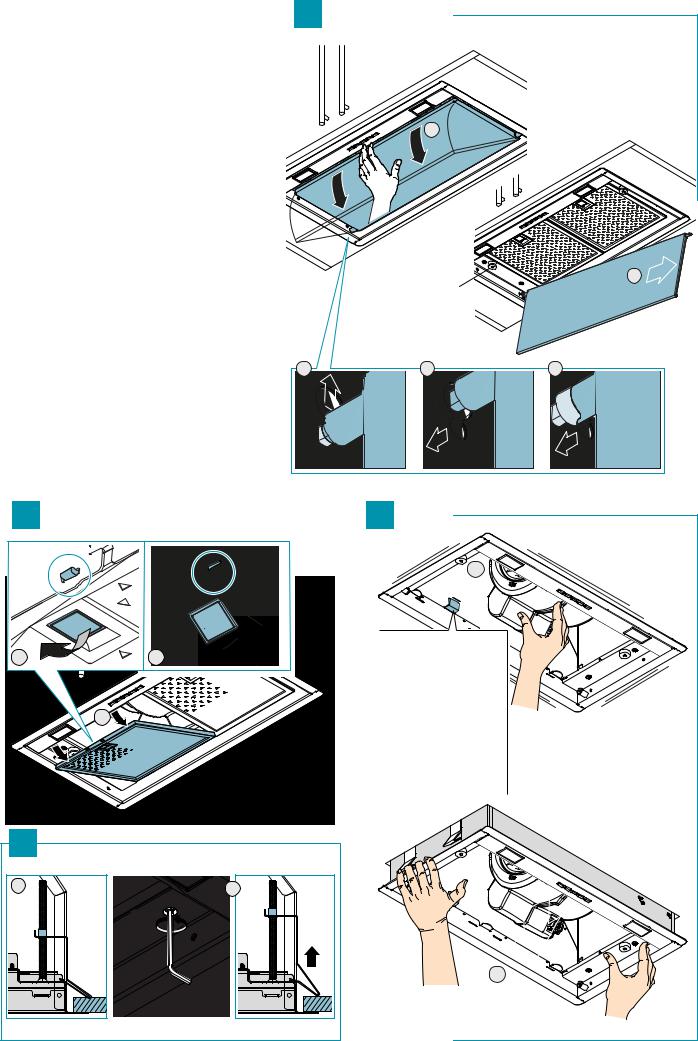
IT |
- Procedura di disinstallazione: rimuovere pannello (11), |
11 |
|
|
|
|
|
rimuovere iltri metallici (12), svitare viti di tenuta(13), |
|
|
|
|
|
sbloccare gruppo incasso (14). |
|
|
|
EN |
- How to uninstall: remove panel (11), remove metal |
|
|
|
|
|
|
ilters (12), unscrew ixing screws (13), release built-in |
|
|
|
|
|
unit (14). |
|
|
|
DE |
- Demontage-Methode: Platte entfernen (11), Metall- |
|
|
|
|
|
|
ilter entfernen (12), Dichtungsschrauben lösen (13), |
|
|
|
|
|
Einbaugruppe freigeben(14). |
|
|
|
FR |
- Procédure de désinstallation : déposer le panneau |
|
1 |
|
|
|
|
(11), enlever les iltres métalliques (12), dévisser les vis |
|
|
|
|
|
de ixation (13), extraire le groupe à encastrement (14). |
|
|
|
ES |
- Procedimiento de desmontaje: quite el panel (11), quite |
|
|
|
|
|
|
los iltros metálicos (12), destornille los tornillos de |
|
|
|
|
|
ijación (13), desbloquee el grupo de empotrado (14). |
|
|
|
RU - Демонтаж: снять панель (11), демонтировать |
|
|
|
||
|
|
металлические фильтры (12), отпустить крепежные |
|
|
|
|
|
винты (13), разблокировать вытяжку (14). |
|
|
|
PL |
- Procedura dezinstalacji: zdjąć panel (11), zdjąć meta- |
|
|
|
|
|
|
lowe iltry (12), odkręcić śruby przytrzymujące (13), |
|
|
|
|
|
odblokować zespół do zabudowy (14). |
|
|
|
NL |
- Demontageprocedure: verwijder het paneel (11), ver- |
|
|
5 |
|
|
|
wijder de metalen ilters (12), schroef de afdichtings- |
|
|
|
|
|
|
|
|
|
|
|
schroeven (13) los, deblokkeer de inbouwgroep (14). |
|
|
|
PT |
- Procedimento de desinstalação: remover o painel (11), re- |
|
|
|
|
|
|
mover os iltros metálicos (12), desaparafusar os parafusos |
|
|
|
|
|
de vedação(13) e desbloquear o grupo de embutir (14). |
|
|
|
DK - Procedure for nedtagning: jern panelet (11), jern |
|
|
|
||
|
|
metaliltrene (12), skru skruerne, der holder emhætten |
|
|
|
|
|
fast, løse (13), frigør enheden til indbygning (14). |
2 |
3 |
4 |
SE |
- Procedur för avinstallation: ta bort panelen (11), ta |
|
|
|
|
|
|
bort metallfettiltren (12), skruva loss tätningsskru- |
|
|
|
|
|
varna (13) och frigör den inbyggda enheten (14). |
|
|
|
FI |
- Asennuksen purkaminen: poista levy (11), poista me- |
|
|
|
|
|
|
tallisuodattimet (12), avaa kiinnitysruuvit (13), irrota |
|
|
|
|
|
upotettu yksikkö (14). |
|
|
|
NO - Prosedyre for avinstallering: jern panelet (11), jern |
|
|
|
||
|
|
metalliltrene (12), skru av holdeskruene (13), frigjør |
|
|
|
|
|
innfellingsenheten (14). |
|
|
|
|
12 |
14 |
|
||
|
|
|
|
1 |
|
|
|
|
IT |
- Stafa di sicurezza (Tirare!) |
|
|
1 |
2 |
EN |
- Safety bracket (Pull!) |
|
|
DE |
- Sicherungsbügel (Daran ziehen!) |
|
||
|
|
|
|
||
|
|
|
FR |
- Patte de sécurité (Tirer !) |
|
|
|
|
ES |
- Abrazadera de seguridad (¡Tire!) |
|
|
|
|
RU |
- Предохранительный кронштейн (Потянуть!) |
|
|
|
3 |
PL |
- Obejma zabezpieczająca (Pociągnąć!) |
|
|
|
NL |
- Veiligheidsbeugel (Trekken!) |
|
|
|
|
|
|
||
|
|
|
PT |
- Suporte de segurança (Puxar!) |
|
|
|
|
DK |
- Sikkerhedsstænger (Træk!) |
|
|
|
|
SE |
- Säkerhetsfäste (Dra!) |
|
|
|
|
FI |
- Turvavipu (Vedä!) |
|
|
|
|
NO |
- Sikkerhetsbrakett (Trekk!) |
|
13 |
|
|
|
||
|
1 |
2 |
|
|
|
|
|
|
|
|
|
|
|
V1 (x4) |
|
|
|
|
|
|
|
2 |
|
8
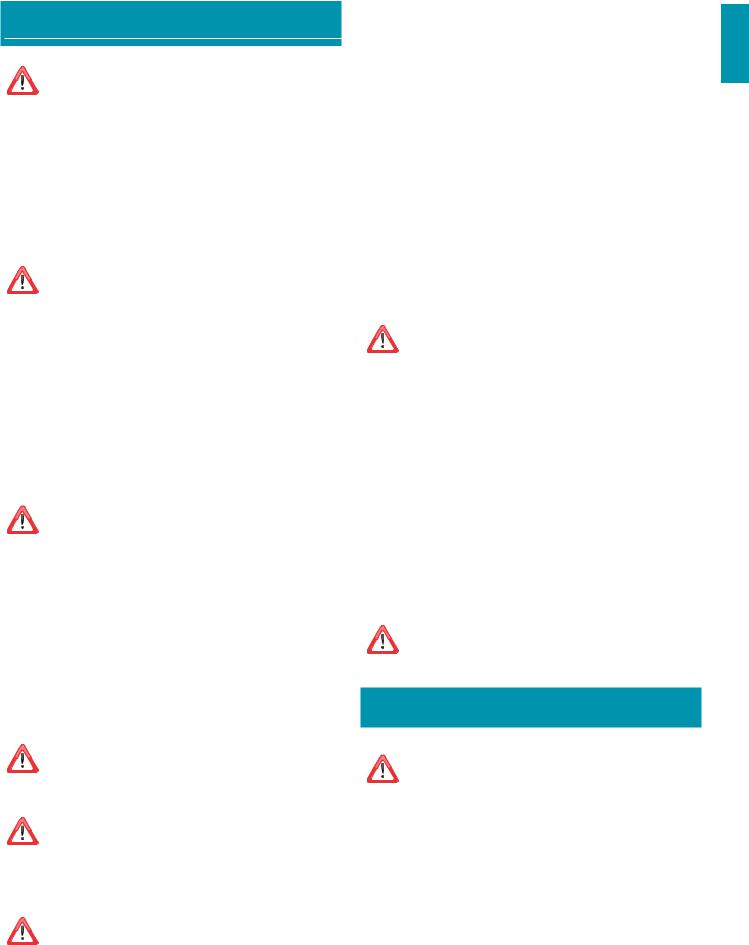
ISTRUZIONI DI SICUREZZA
E AVVERTENZE
Il lavoro d’installazione deve essere eseguito da installatori competenti e qualiicati, secondo quanto indicato nel presente libretto e rispettando le norme in vigore.
Se il cavo di alimentazione o altri componenti sono danneggiati, la cappa NON deve essere utilizzata: staccare la cappa dall'alimentazione elettrica e contattare il Rivenditore o un Centro Assistenza Tecnica autorizzato per la riparazione.
Non modiicare la struttura elettrica, meccanica e funzionale dell'apparecchiatura.
Non tentare di efettuare da soli riparazioni o sostituzioni: gli interventi efettuati da persone non competenti e qualiicate possono provocare danni, anche molto gravi, a cose e/o persone non coperti da garanzia del Costruttore.
AVVERTENZE PER L'INSTALLATORE
SICUREZZA TECNICA
Prima di installare la cappa controllare l'integrità e funzionalità di ogni sua parte: se si notano anomalie non procedere nell'installazione e contattare il Rivenditore.
Nel caso sia stato riscontrato un difetto estetico la cappa NON deve essere installata; riporla nel suo imballo originale e contattare il Rivenditore.
Una volta installata non sarà accettato alcun reclamo per difetti estetici.
Durante l'installazione utilizzare sempre mezzi di protezione personale (es.: scarpe antiinfortunistiche) ed adottare comportamenti prudenti e corretti.
Il kit di issaggio (viti e tasselli) fornito con la cappa è utilizzabile unicamente su pareti in muratura: in caso di installazione su pareti di materiale diverso, valutare altri sistemi di issaggio tenendo conto della resistenza del muro e del peso della cappa (indicato a pag. 2).
Tenere presente che l’installazione con sistemi di issaggio diversi da quelli forniti o non conformi può comportare rischi di natura elettrica e di tenuta meccanica.
Non installare la cappa in ambienti esterni e non esporla ad agenti atmosferici (pioggia, vento, ecc...).
SICUREZZA ELETTRICA
L’impianto elettrico al quale viene collegata la cappa deve essere a norma e munito di collegamento a terra secondo le norme di sicurezza del Paese di utilizzo; deve essere inoltre conforme alle normative Europee sull’antidisturbo radio.
Prima di installare la cappa veriicare che la tensione di rete corrisponda a quella riportata dalla targhetta posta all’interno della cappa.
La presa usata per il collegamento elettrico deve essere facilmente raggiungibile con l’apparecchiatura installata: in caso contrario, prevedere un interruttore generale per disconnettere la cappa al bisogno.
Ogni eventuale modiica all’impianto elettrico dovrà essere eseguita solo da un elettricista qualiicato.
La lunghezza massima della vite di issaggio del camino (fornita dal fabbricante) è di 13 mm. L'utilizzo di viti non conformi con le presenti istruzioni può comportare rischi di natura elettrica.
In caso di malfunzionamenti dell’apparecchio, non tentare di risolvere da soli il problema, ma contattare il Rivenditore o un Centro di Assistenza autorizzato per la riparazione.
Durante l'installazione della cappa, disinserire l’apparecchio togliendo la spina o agendo sull’interruttore generale.
SICUREZZA SCARICO FUMI
Non collegare l’apparecchio a condotti di scarico dei fumi prodotti dalla combustione (ad es. caldaie, caminetti, ecc...)
Prima dell'installazione della cappa assicurarsi che siano rispettate tutte le normative vigenti sullo scarico dell’aria all’esterno del locale.
AVVERTENZE PER L'UTILIZZATORE
Queste avvertenze sono state redatte per la vostra sicurezza e per quella degli altri, Vi preghiamo, dunque, di leggere attentamente questo libretto in tutte le sue parti prima di utilizzare l’apparecchio o di efettuare opera-
zioni di pulizia sullo stesso.
Il Costruttore declina ogni responsabilità per eventuali danni che possano, direttamente o indirettamente, essere causati a persone, cose ed animali domestici conseguenti alla mancata osservanza delle avvertenze di sicurezza indicate in questo libretto.
È molto importante che questo libretto istruzioni sia conservato insieme all’apparecchiatura per qualsiasi futura consultazione.
Se l’apparecchio dovesse essere venduto o trasferito ad un’altra persona, assicurarsi che anche il libretto venga fornito, in modo che il nuovo utente possa essere messo al corrente del funzionamento della cappa e delle avvertenze relative.
Dopo l’installazione delle cappe in acciaio inox è necessario eseguire la pulizia della stessa per rimuovere i residui di collante del protettivo e le eventuali macchie di grasso e oli, che, se non rimosse, possono causare il deterioramento irreversibile della supericie della cappa. Per questa operazione il costruttore raccomanda l’utilizzo delle salviette in dotazione, disponibili anche in acquisto
Esigere parti di ricambio originali.
DESTINAZIONE D'USO
L’apparecchio è destinato solo ed esclusivamente per l'aspirazione di fumi generati dalla cottura di alimenti in ambito domestico, non professionale: qualsiasi utilizzo diverso da questo è improprio, può provocare danni a persone, cose ed animali domestici e solleva il Costruttore da qualsiasi responsabilità.
L’apparecchio può essere utilizzato da bambini di età non inferiore a 8 anni e da persone con ridotte capacità isiche, sensoriali o mentali, o prive di esperienza o della necessaria conoscenza, purché sotto sorveglianza oppure dopo che le stesse abbiano ricevuto istruzioni relative all’uso sicuro dell’apparecchio e alla comprensione dei pericoli ad esso inerenti. I bambini non devono giocare con l’apparecchio. La pulizia e la manutenzione a cura dell’u- tilizzatore non deve essere efettuata da bambini senza sorveglianza.
AVVERTENZE PER L'UTILIZZO E LA PULIZIA
Prima di procedere a qualsiasi operazione di pulizia o di manutenzione, disinserire l’apparecchio togliendo la spina o agendo sull’interruttore ge-
nerale.
Non utilizzare la cappa con le mani bagnate o piedi scalzi.
Quando l’apparecchio non viene usato, controllare sempre che tutte le parti elettriche, (luci, aspiratore), siano spente.
Il peso massimo complessivo di eventuali oggetti posizionati o appesi (ove previsto) sulla cappa non deve superare 1,5 Kg.
Controllare le friggitrici durante l’uso: I’olio surriscaldato potrebbe iniammarsi. Non accendere iamme libere sotto la cappa.
Non preparare cibi alla iamma sotto la cappa.
Non utilizzare mai la cappa senza i iltri metallici antigrasso; grasso e sporco in questo caso si depositerebbero nell'apparecchio compromettendone il funzionamento.
Parti accessibili della cappa possono essere calde se utilizzate insieme con apparecchi di cottura.
Non efettuare operazioni di pulizia quando parti della cappa sono ancora calde.
Se la pulizia non è condotta secondo le modalità e i prodotti indicati nel presente libretto è possibile un rischio di incendio.
Disinserire l’interruttore generale quando l’apparecchio non viene utilizzato per periodi prolungati di tempo.
In caso di utilizzo contemporaneo di altre utenze (caldaie, stufe, caminetti, ecc.) alimentate a gas o con altri combustibili, provvedere ad una adeguata ventilazione del locale in cui avviene l’aspirazione dei fumi, secondo le norme vigenti.
INSTALLAZIONE
parte riservata solo a personale qualiicato
Prima di efettuare l'installazione della cappa, leggere attentamente il cap. "ISTRUZIONI DI SICUREZZA E AVVERTENZE".
CARATTERISTICHE TECNICHE
I dati tecnici dell'apparecchio sono riportati su etichette posizionate all’interno della cappa.
POSIZIONAMENTO
La distanza minima fra la parte più alta dell'apparecchiatura per la cottura e la parte più bassa della cappa da cucina viene indicata nelle istruzioni di montaggio.
In generale, quando la cappa da cucina è posta su un piano cottura a gas, questa distanza deve essere almeno 65 cm (25,6"). Tuttavia sulla base di un’interpretazione della norma EN60335-2-31 del 11-07-2002 da parte del TC61 (subclause 7.12.1 meeting 15 agenda item 10.11), la distanza minima tra piano cottura e parte inferiore della cappa può essere ridotta alla quota riportata nelle istruzioni di montaggio.
Se le istruzioni del piano di cottura a gas speciicano una distanza maggiore, bisogna tenerne conto.
Non installare la cappa in ambienti esterni e non esporla ad agenti atmosferici (pioggia, vento, ecc...).
<![endif]>ITALIANO
9
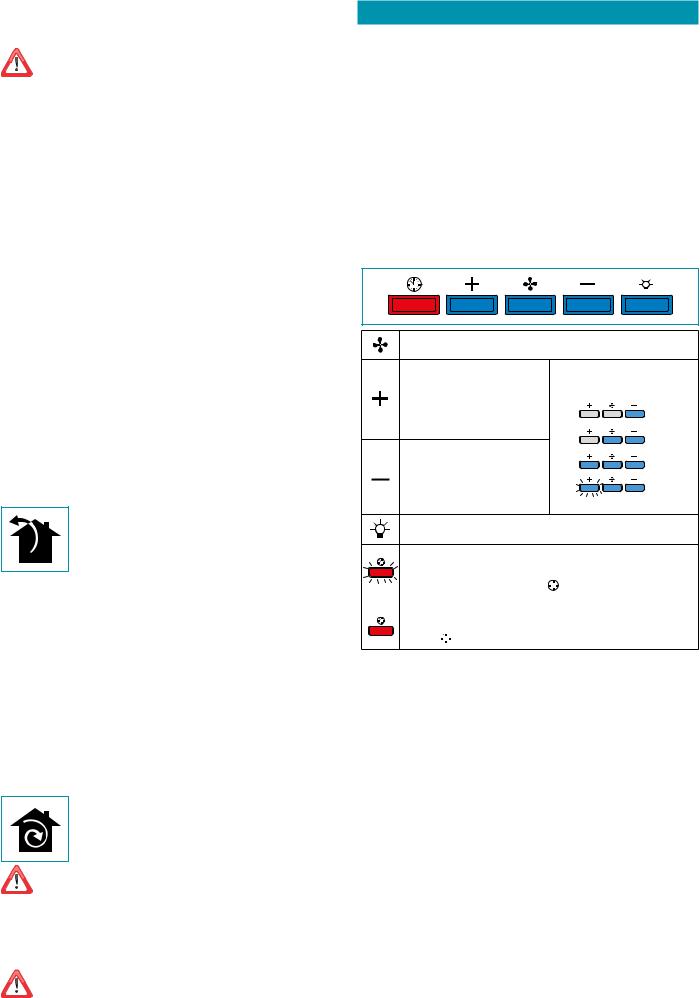
COLLEGAMENTO ELETTRICO
(parte riservata solo a personale qualiicato)
Prima di efettuare qualsiasi operazione sulla cappa scollegare l’apparecchio dalla rete elettrica.
Assicurarsi che non vengano scollegati o tagliati ili elettrici all’interno della cappa:
in caso contrario contattare il Centro Assistenza più vicino. Per l’allacciamento elettrico rivolgersi a personale qualiicato.
Il collegamento deve essere eseguito in conformità con le disposizioni di legge in vigore.
Prima di collegare la cappa alla rete elettrica, controllare che:
Пla tensione di rete corrisponda a quella riportata sui dati di targa posti all’interno della cappa;
Пl’impianto elettrico sia a norma e possa sopportare il carico (vedi caratteristiche tecniche posizionate all’interno della cappa);
Пla spina e il cavo, di alimentazione, non devono entrare in contatto con temperature superiori a 70 °C;
Пl’impianto di alimentazione sia munito di eicace e corretto collegamento di terra secondo le norme vigenti;
Пla presa usata per il collegamento sia facilmente raggiungibile una volta installata la cappa.
In caso di :
Пapparecchi dotati di cavo senza spina: la spina da utilizzare deve essere di tipo “normalizzato”. Il ili devono essere collegati come segue: giallo-verde per la messa a terra, blu per il neutro e il ilo marrone per la fase. La spina deve essere collegata ad un'adeguata presa di sicurezza.
Пapparecchio isso non provvisto di cavo di alimentazione e di spina, o di altro dispositivo che assicuri la disconnessione dalla rete, con una distanza di apertura dei contatti che consenta la disconnessione completa nelle condizioni della categoria di sovratensione III. Tali dispositivi di disconnessione devono essere previsti nella rete di alimentazione conformemente alle regole di installazione.
Il cavo di terra giallo/verde non deve essere interrotto dall’interruttore.
Il Costruttore declina ogni responsabilità nel caso le norme di sicurezza non vengano rispettate.
SCARICO FUMI
CAPPA AD EVACUAZIONE ESTERNA (ASPIRANTE)
In questa versione, fumi e vapori vengono convogliati verso l'esterno attraverso il tubo di scarico.
A tal ine, il raccordo d'uscita della cappa, deve essere collegato tramite un tubo, ad un'uscita esterna.
Il tubo d'uscita deve avere:
Пun diametro non inferiore a quello di raccordo della cappa.
Пuna leggera inclinazione verso il basso (caduta) nei tratti orizzontali per evitare che la condensa reluisca nel motore.
Пil numero minimo indispensabile di curve.
Пla lunghezza minima indispensabile per evitare vibrazioni e di ridurre la capacità aspirante della cappa.
E' necessario isolare la tubazione se passa attraverso ambienti freddi.
Per impedire ritorni d'aria dall'esterno, una valvola di non ritorno è presente in presenza di motori con 800m3/h o superiori.
Deviazione per la Germania:
quando la cappa da cucina e apparecchi alimentati con energia diversa da quella elettrica sono in funzione simultaneamente, la pressione negativa nel locale non deve superare i 4 Pa (4 x 10-5 bar).
CAPPA A RICICLO INTERNO (FILTRANTE)
In questa versione l’aria passa attraverso i iltri al carbone attivo per essere puriicata e riciclata nell’ambiente.
Controllare che i iltri al carbone attivo siano montati sulla cappa, in caso negativo applicarli come indicato nelle istruzioni di montaggio.
In questa versione valvola di non ritorno non deve essere montata: rimuoverla se presente sul raccordo di uscita aria del motore.
ISTRUZIONI DI MONTAGGIO
parte riservata solo a personale qualiicato
La cappa ha la possibilità di essere installata in varie conigurazioni.
Le fasi di montaggio generiche valgono per tutte le installazioni; seguire invece dove speciicato le fasi corrispondenti all’installazione desiderata.
FUNZIONAMENTO
QUANDO ACCENDERE LA CAPPA?
Accendere la cappa almeno un minuto prima di iniziare a cucinare per convogliare fumi e vapori verso la supericie di aspirazione.
Al termine della cottura lasciare in funzione la cappa ino a completa aspirazione di tutti i vapori e odori: con la funzione Timer, è possibile impostare l'autospegnimento della cappa dopo 15 minuti di funzionamento.
QUALE VELOCITÀ SCEGLIERE?
I velocità: mantiene l’aria pulita con bassi consumi di energia elettrica. II velocità: condizioni normali di utilizzo.
III velocità: presenza di forti odori e vapori.
IV velocità: rapidi smaltimenti di odori e vapori.
QUANDO LAVARE O CAMBIARE I FILTRI?
I iltri metallici devono essere lavati ogni 30 ore di utilizzo.
I iltri carbone attivo, vanno sostituiti ogni 3-4 mesi a seconda dell’utilizzo della cappa. Per ulteriori dettagli vedere cap “MANUTENZIONE”.
PULSANTIERA ELETTRONICA (GRUPPO INCASSO, A+)
Motore ON/OFF
All’avvio, la velocità è quella memorizzata al precedente spegnimento.
Le velocità sono segnalate dai led
presenti nei tasti:
Incremento velocità da 1 a 4
Velocità 4 è attiva solo per alcuni mi-
nuti, poi si attiva velocità 3.
Velocità 1
|
Velocità 2 |
Riduzione velocità da 4 a 1 |
Velocità 3 |
|
|
|
Velocità 4 |
|
(led "+" lampeggiante) |
Accensione / spegnimento luce |
|
TIMER (Led rosso lampeggiante)
Autospegnimento dopo 15min.
La funzione si disattiva (Led rosso spento) se:
-Si preme un'altra volta il tasto TIMER ( 
 ).
).
-Si preme il tasto ON/OFF ( ).
).
ALLARME FILTRI (Led rosso isso con ( ) of )
) of )
Manutenzione iltri antigrasso dopo circa 30 ore di utilizzo.
Premere ( ) per 3 secondi per azzerare il contatore.
) per 3 secondi per azzerare il contatore.
10
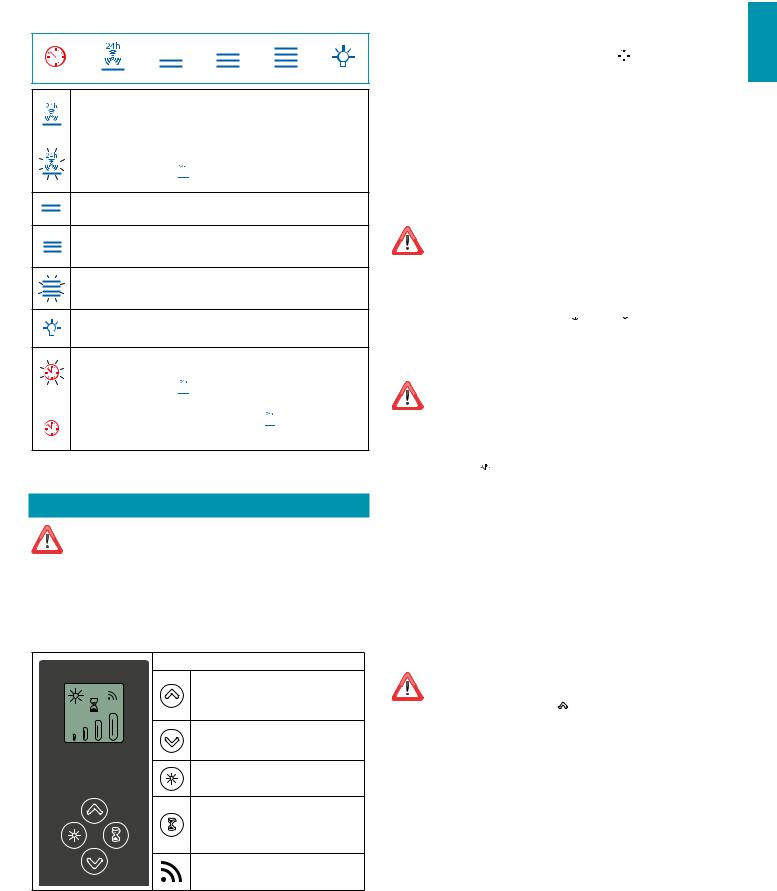
PULSANTIERA TOUCH (GRUPPO INCASSO MURANO)
ON/OFF (led blu isso)
Accensione/spegnimento motore e Vel1
ON/OFF (led blu lampeggiante)
Premuto per più di 3 secondi attiva il ciclo 24h (1h ON -> 3h OFF -> 1h ON) La funzione si disattiva se:
- si spegne il motore (tasto 
 ) - Dopo 24h
) - Dopo 24h
Attivazione Velocità 2
Attivazione Velocità 3
Attivazione Velocità 4 solo per alcuni minuti, poi velocità 3
Accensione / spegnimento luce
TIMER (Led rosso lampeggiante)
Autospegnimento dopo 15min.
La funzione si disattiva (Led rosso spento) se:
-Si spegne il motore (tasto 
 ).
).
-Si varia la velocità.
ALLARME FILTRI (Led rosso isso con motore OFF 
 )
)
Manutenzione iltri antigrasso dopo circa 30 ore di utilizzo.
Premere per 3 secondi per azzerare il contatore.
UTILIZZO DEL RADIOCOMANDO
AVVERTENZE!:
Posizionare la cappa lontano da sorgenti di onde elettromagnetiche (es. forni a microonde) che potrebbero interferire con il radiocomando e con
l’elettronica della cappa.
La distanza massima di funzionamento è di 5 metri che può variare in difetto in presenza di interferenze elettromagnetiche.
Radiocomando operante a 433,92MHz.
Il radiocomando è composto da due parti:
-la ricevente integrata nella cappa;
-la trasmittente mostrata qui in igura.
DESCRIZIONE COMANDI TRASMITTENTE
UP
Accensione motore e incremento velocità da 1 a 4. La quarta velocità è attiva solo per alcuni minuti.
DOWN
Decremento velocità e spegnimento motore
Luce ON-OFF
TIMER ON: Autospegnimento del motore dopo 15min.
La funzione si disattiva automaticamente se si spegne il motore (tasto  )
)
Trasmissione comando attiva
Il radiocomando è opzionale per il GRUPPO INCASSO e A+.
In caso di acquisto, seguire per intero la procedura descritta qui sotto.
Per IL GRUPPO INCASSO MURANO, saltare la procedura di attivazione.
PROCEDURA DI ATTIVAZIONE (per GRUPPO INCASSO e A+)
Prima di utilizzare il radiocomando, eseguire la seguente procedura sulla pulsantiera della cappa:
•Premere contemporaneamente i tasti LUCE ( ) e TIMER (
) e TIMER ( ) ino a che tutti i led iniziano a lampeggiare.
) ino a che tutti i led iniziano a lampeggiare.
•Rilasciare i due tasti e premere ancora il tasto LUCE ( ) ino a quando tutti i led saranno accesi.
) ino a quando tutti i led saranno accesi.
•Rilasciare il tasto LUCE ( ): adesso la ricevente è attiva.
): adesso la ricevente è attiva.
La procedura serve anche per la disattivazione della ricevente.
CAMBIO CODICE RADIOCOMANDO
In presenza di un solo radiocomando passare direttamente al punto 2.
In presenza di più radiocomandi nella stessa stanza, è possibile generare un nuovo codice con la seguente procedura.
Togliere alimentazione alla cappa prima di efettuare la procedura.
1) - GENERARE UN NUOVO CODICE
La procedura va eseguita sul radiocomando.
•Premere contemporaneamente i tasti LUCE  e TIMER
e TIMER  ino a che il display incomincia a lampeggiare.
ino a che il display incomincia a lampeggiare.
•Premere il tasto DOWN  del radiocomando: la memorizzazione del nuovo codice è confermata da 3 brevi lampeggi del display. Il nuovo codice annulla e sostituisce il precedente codice di fabbrica.
del radiocomando: la memorizzazione del nuovo codice è confermata da 3 brevi lampeggi del display. Il nuovo codice annulla e sostituisce il precedente codice di fabbrica.
Ricollegare la cappa alla rete elettrica, veriicando che luci e motore siano spenti.
2A) - ASSOCIAZIONE DEL RADIOCOMANDO ALLA CAPPA CON PULSANTIERA ELETTRONICA
premere il tasto TIMER ( ) della pulsantiera della cappa per 2 secondi: il led rosso si accende.
) della pulsantiera della cappa per 2 secondi: il led rosso si accende.
premere un tasto qualsiasi del radiocomando entro 10 secondi.
2B) - ASSOCIAZIONE DEL RADIOCOMANDO ALLA CAPPA CON PULSANTIERA TOUCH
premere il tasto LUCE ( ) della pulsantiera della cappa per 2 secondi: il led rosso si accende.
) della pulsantiera della cappa per 2 secondi: il led rosso si accende.
premere un tasto qualsiasi del radiocomando entro 10 secondi.
RIPRISTINO CODICE DI FABBRICA
la procedura è da efettuarsi in caso di cessione della cappa.
Togliere alimentazione alla cappa prima di efettuare la procedura.
•Premere contemporaneamente i tasti UP  e DOWN
e DOWN  del radiocomando per più di 5 secondi: l'avvenuto ripristino viene confermato da tre brevi lampeggi del display.
del radiocomando per più di 5 secondi: l'avvenuto ripristino viene confermato da tre brevi lampeggi del display.
•Ricollegare la cappa alla rete elettrica.
•Procedere con l’associazione tra cappa e radiocomando come descritto nel punto 2.
<![endif]>ITALIANO
11
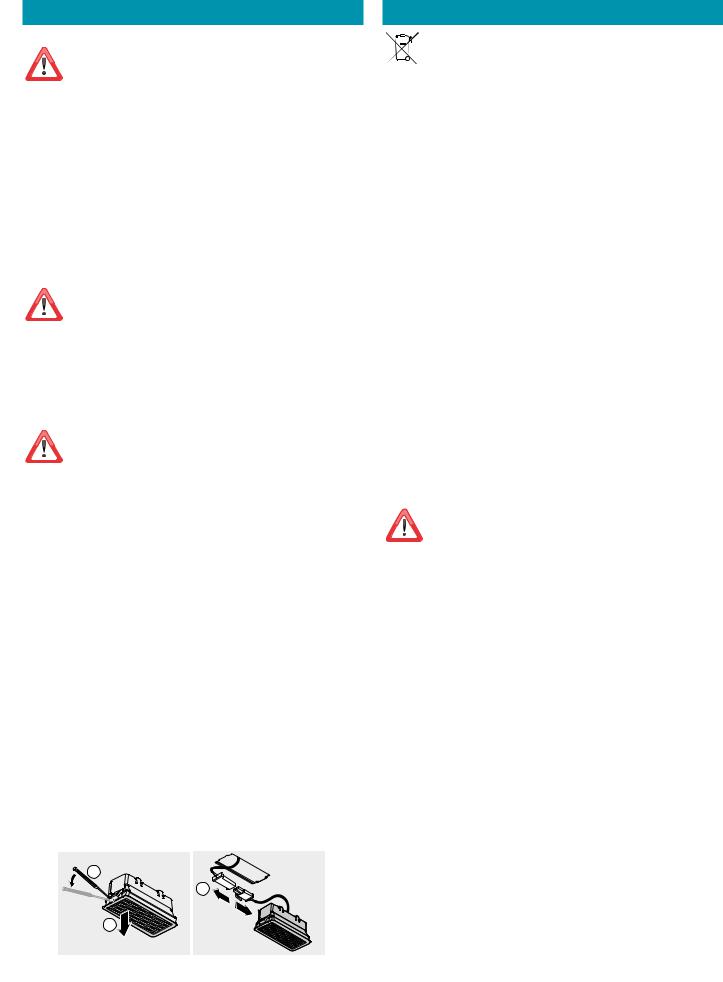
MANUTENZIONE |
SMALTIMENTO A FINE VITA |
Prima di procedere a qualsiasi operazione di pulizia o di manutenzione, disinserire l’apparecchio togliendo la spina o agendo sull’interruttore generale.
Non si devono utilizzare detergenti contenenti sostanze abrasive, acide o corrosive e panni con superici ruvide.
Una costante manutenzione garantisce un buon funzionamento e rendimento nel tempo. Particolari attenzioni vanno rivolte ai iltri metallici antigrasso: la pulizia frequente dei iltri e dei loro supporti garantisce che non si accumulino grassi iniammabili.
PULIZIA SUPERFICI ESTERNE
Si raccomanda di pulire le superici esterne della cappa almeno ogni 15 giorni per evitare che le sostanze oleose o grasse possano intaccarle. Per la pulizia della cappa, realizzata in acciaio inox spazzolato, il Costruttore consiglia l'utilizzo delle salviette "Magic Steel" che si possono anche ordinare on-line sul sito www.e-falmec.com.
In alternativa e per tutti gli altri tipi di superici, la pulizia va eseguita usando un panno umido leggermente imbevuto di detersivo neutro liquido o con alcool denaturato.
la pulizia con un accurato risciacquo e asciugatura con panni morbidi.
Non utilizzare troppa acqua in prossimità della pulsantiera e dei dispositivi di illuminazione per evitare che l'umidità raggiunga parti elettroniche.
La pulizia dei pannelli in vetro va eseguita solo con detergenti speciici non corrosivi o abrasivi utilizzando un panno morbido.
Il Costruttore declina ogni responsabilità qualora non vengano rispettate tali istruzioni.
PULIZIA SUPERFICI INTERNE
E’ vietata la pulizia di parti elettriche o parti relative al motore all’interno della cappa, con liquidi o solventi.
Per le parti metalliche interne vedi paragrafo precedente.
Il simbolo del cestino barrato riportato sull’apparecchiatura in suo possesso indi-  ca che il prodotto è un RAEE, cioè un “Riiuto derivante dalle Apparecchiature
ca che il prodotto è un RAEE, cioè un “Riiuto derivante dalle Apparecchiature  Elettriche ed Elettroniche” e pertanto non deve essere gettato nella spazzatura indiferenziata (cioè insieme ai “riiuti urbani misti”), ma deve essere gestito separatamente così da essere sottoposto ad apposite operazioni per il suo riutilizzo, oppure a uno speciico trattamento, per rimuovere e smaltire in modo sicuro le eventuali sostanze dannose per l’ambiente ed estrarre le materie prime che possono essere riciclate. Lo smaltimento corretto di questo prodotto contribuirà a salvare preziose risorse ed evitare potenziali efetti negativi per la salute umana e per l’ambiente, che potrebbero essere causati da uno
Elettriche ed Elettroniche” e pertanto non deve essere gettato nella spazzatura indiferenziata (cioè insieme ai “riiuti urbani misti”), ma deve essere gestito separatamente così da essere sottoposto ad apposite operazioni per il suo riutilizzo, oppure a uno speciico trattamento, per rimuovere e smaltire in modo sicuro le eventuali sostanze dannose per l’ambiente ed estrarre le materie prime che possono essere riciclate. Lo smaltimento corretto di questo prodotto contribuirà a salvare preziose risorse ed evitare potenziali efetti negativi per la salute umana e per l’ambiente, che potrebbero essere causati da uno
smaltimento inappropriato dei riiuti.
Vi preghiamo di contattare le autorità locali per ulteriori dettagli sul punto di smaltimento designato più vicino. Potrebbero venire applicate delle penali per lo smaltimento scorretto di questi riiuti in conformità alla legislazione nazionale.
INFORMAZIONI SULLO SMALTIMENTO IN ITALIA
In Italia le apparecchiature RAEE devono perciò essere consegnate:
-ai Centri di Raccolta (chiamati anche isole ecologiche o piattaforme ecologiche) allestiti dai Comuni o dalle Società di igiene urbana (in molte località viene anche efettuato il servizio di ritiro a domicilio delle apparecchiature RAEE ingombranti);
-al negozio presso il quale si acquista una nuova apparecchiatura, che è tenuto a ritirarle gratuitamente (ritiro “uno contro uno”);
-ad un negozio qualunque*, che è tenuto a ritirarle gratuitamente e senza obbligo di acquisto (ritiro “uno contro zero”).
In questo caso:
1) l’apparecchiatura RAEE, per poter essere riconsegnata, deve avere “piccolissime dimensioni” (altezza, profondità e larghezza minori di 25 cm);
* 2) il negozio al quale viene riconsegnata l’apparecchiatura RAEE deve avere una supericie di vendita superiore a 400 mq.
INFORMAZIONI SULLO SMALTIMENTO IN NAZIONI DELL'UNIONE EUROPEA
La Direttiva comunitaria sulle apparecchiature RAEE è stata recepita in modo diverso da ciascuna nazione, pertanto se si desidera smaltire questa apparecchiatura suggeriamo di contattare le autorità locali o il Rivenditore per chiedere il metodo corretto di smaltimento.
INFORMAZIONI SULLO SMALTIMENTO IN NAZIONI NON APPARTENENTI ALL'UNIONE EUROPEA
Il simbolo del cestino barrato è valido solamente nell’Unione Europea: se si desidera smaltire questa apparecchiatura in altri Paesi suggeriamo di contattare le autorità locali o il Rivenditore per chiedere il metodo corretto di smaltimento.
FILTRI METALLICI ANTIGRASSO
Si consiglia di lavare frequentemente i iltri metallici (almeno ogni mese) lasciandoli in ammollo per circa 1 ora in acqua bollente con detersivo per piatti, evitando di piegarli. Non usare detergenti corrosivi, acidi o alcalini.
Risciacquarli con cura ed attendere che siano ben asciutti prima di rimontarli.
Il lavaggio in lavastoviglie è permesso, ma potrebbe creare imbrunimenti al materiale dei iltri: per ridurre questo inconveniente utilizzare lavaggi a basse temperature (55°C max.). Per l’estrazione e l'inserimento dei iltri metallici antigrasso vedi istruzioni di montaggio.
ATTENZIONE!
Il Costruttore si riserva il diritto di apportare modiiche alle apparecchiature in qualsiasi momento e senza preavviso. La stampa, la traduzione e la riproduzione anche parziale del presente manuale s’intendono vincolate dall’autorizzazione del Costruttore.
Le informazioni tecniche, le rappresentazioni graiche e le speciiche presenti in questo manuale sono indicative e non divulgabili.
La lingua di stesura del manuale è l’italiano, il Costruttore non si rende responsabile per eventuali errori di trascrizione o traduzione.
FILTRI AL CARBONE ATTIVO
Questi iltri trattengono gli odori presenti nell’aria che li attraversa. L’aria depurata viene così rimessa nell’ambiente.
I iltri al carbone attivo devono essere sostituiti mediamente ogni 3-4 mesi in condizioni di
utilizzo normale.
Per la sostituzione dei iltri al carbone attivo vedi istruzioni di montaggio.
ILLUMINAZIONE
La cappa è dotata di illuminazione tramite faretti led ad alta eicienza, basso consumo e durata molto elevata in condizioni di normale utilizzo.
Nel caso si rendesse necessaria la sostituzione del faretto procedere come in igura.
1
3
2 |
12V |
|
12
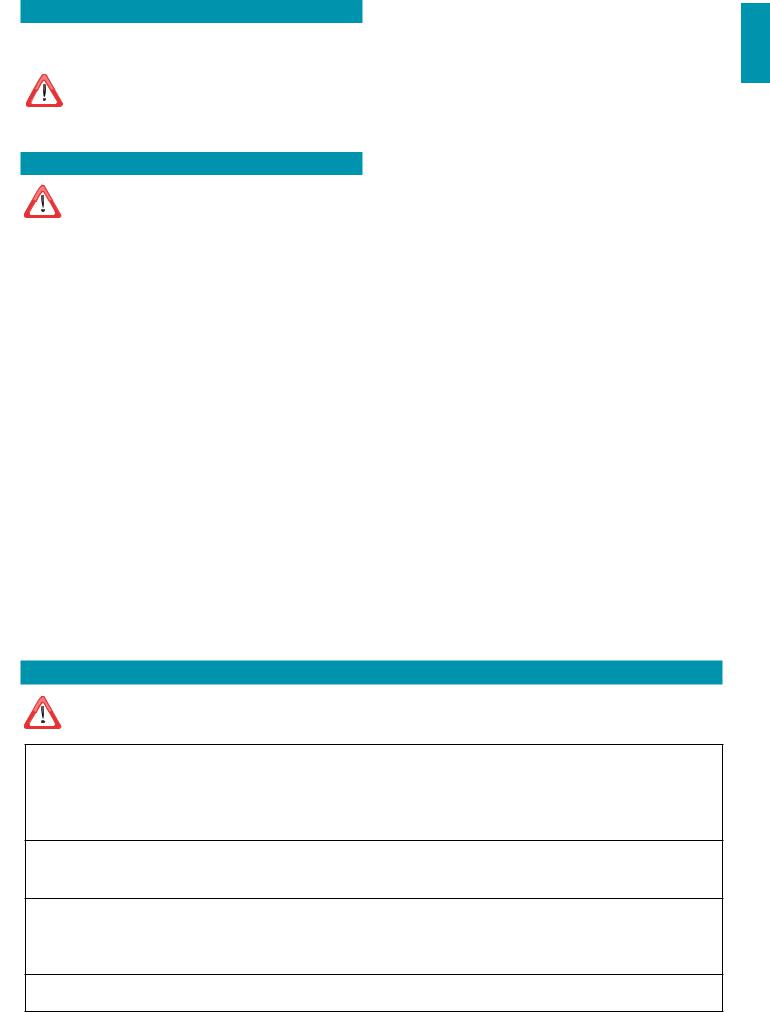
GARANZIA (solo per l'Italia)
La sua nuova apparecchiatura è coperta da garanzia. Le condizioni di garanzia sono riportate per esteso nel paragrafo successivo.
La casa costruttrice non risponde delle possibili inesattezze, imputabili ad errori di stampa o di trascrizione, contenute nel presente libretto.
Si riserva di apportare ai propri prodotti quelle modiiche che ritenesse necessarie o utili, anche nell’interesse dell’utenza, senza pregiudicare le caratteristiche essenziali di funzionalità e di sicurezza.
CONDIZIONI DI GARANZIA (solo per l'Italia)
IMPORTANTE!
La presente garanzia è valida solo per l’Italia (Guarantee conditions are valid only for Italy).
DECRETO LEGISLATIVO DEL 30/06/2003 N. 196 - ART. 7
Codice in materia di protezione dei dati personali.
1.L’interessato ha diritto di ottenere la conferma dell’esistenza o meno di dati personali che lo riguardano, anche se non ancora registrati, e la loro comunicazione in forma intelleggibile.
2.L’interessato ha diritto di ottenere l’indicazione:
a)dell’origine dei dati personali;
b)delle inalità e modalità del trattamento;
c)della logica applicata in caso di trattamento efettuato con l’ausilio di strumenti elettronici;
d)degli estremi identiicativi del titolare, dei responsabili e del rappresentante designato ai sensi dell’articolo 5, comma 2;
e)dei soggetti o delle categorie di soggetti ai quali i dati personali possono essere comunicati o che possono venirne a conoscenza in qualità di rappresentante designato nel territorio dello Stato, di responsabili o incaricati.
3.L’interessato ha diritto di ottenere:
a)l’aggiornamento, la rettiicazione ovvero, quando vi ha interesse, l’integrazione dei dati;
b)la cancellazione, la trasformazione in forma anonima o il blocco dei dati trattati in violazione di legge, compresi quelli di cui non è necessaria la conservazione in relazione agli scopi per i quali i dati sono stati raccolti o successivamente trattati;
c)l’attestazione che le operazioni di cui alle lettere a) e b) sono state portate a conoscenza, anche per quanto riguarda il loro contenuto , di coloro ai quali i dati sono stati comunicati o difusi, eccettuato il caso in cui tale adempimento si rileva impossibile o comporta un impiego di mezzi manifestamente sproporzionato rispetto al diritto tutelato.
4.L’interessato ha diritto di opporsi, in tutto o in parte:
a)per motivi legittimi al trattamento dei dati personali che lo riguardano, ancorché pertinenti allo scopo della, raccolta;
b)al trattamento di dati personali che lo riguardano a ini di invio di materiale pubblicitario o di vendita diretta o per il compimento di ricerche di mercato o di comunicazione commerciale.
Titolare del trattamento dei dati è Falmec S.P.A.
Via dell’Artigianato, 42 - Vittorio Veneto (TV).
CONDIZIONI DI GARANZIA
•L’apparecchio è garantito dalla Casa costruttrice Falmec S.p.A (www.falmec.com) per un periodo di 24 mesi dalla data del suo acquisto comprovata da ricevuta iscale o altro documento reso iscalmente obbligatorio.
•La garanzia sarà prestata con la sostituzione o riparazione gratuita delle parti che risultino difettose per vizi delle stesse imputabili a Falmec S.p.A..
•Non sono coperte dalla presente garanzia tutte le parti che dovessero risultare difettose, danneggiate e/o viziate a causa di uso improprio dell’apparecchio, di negligenza o trascuratezza nell’uso (mancata osservanza delle istruzioni per il funzionamento dell’apparecchio), di inesatta installazione, di mancata ovvero errata manutenzione, di manutenzioni operate da personale non autorizzato, di danni da trasporto, ovvero per circostanze non riferibili a difetti di funzionamento imputabili a Falmec S.p.A. e/o comunque direttamente imputabili alla Casa costruttrice. Si precisa inoltre che non rientrano nelle prestazioni in garanzia gli interventi inerenti l’installazione e l’allacciamento agli impianti elettrici e/o di alimentazione.
•Vengono peraltro esclusi dalla presente garanzia i componenti dell’apparecchio soggetti ad usura, quali speciicatamente ma non esaustivamente: lampadine di varie tipologie, iltri metallici, iltri carbone, ecc.
•La Casa costruttrice declina ogni responsabilità per eventuali danni che possono, direttamente o indirettamente, essere causati a persone, cose ed animali domestici in conseguenza alla mancanza di tutte le prescrizioni indicate nell’apposito libretto istruzioni e concernenti, specialmente, le avvertenze in tema di installazione, uso e manutenzione dell’apparecchio.
•Trascorsi i 24 mesi, l’apparecchio non sarà più coperto da garanzia e l’assistenza verrà prestata addebitando le parti sostituite, le spese di manodopera e di trasporto dei personale e dei materiali, secondo le tarife vigenti in possesso dei personale dei Servizio Assistenza Tecnica autorizzato dalla Casa costruttrice. In presenza di un intervento efettuato presso un Centro Assistenza Tecnica autorizzato, l’apparecchio vi sarà recapitato a spese e rischio dell’utente.
•La presente garanzia è valida per la fornitura ed installazione dell’apparecchio avvenuta nel solo territorio italiano.
Titolare del trattamento dei dati è Falmec S.P.A.
Via dell’Artigianato, 42 - Vittorio Veneto (TV).
CERTIFICATO DI GARANZIA (SOLO PER ITALIA - DA CONSERVARE)
Questo certiicato di garanzia non deve essere spedito, ma conservato con la ricevuta iscale, o altro documento reso iscalmente obbligatorio, che comprovi la data d’acquisto della cappa. In caso necessiti intervenire per anomalie di funzionamento, si prega di contattare un Centro di Assistenza Tecnica autorizzato, tenendo a portata di mano i dati sotto indicati:
Matricola/Serial Number (vedere ultima pagina libretto o targhetta dei dati tecnici posta all'interno della cappa):
È ASSOLUTAMENTE NECESSARIO INDICARE IL NUMERO MATRICOLA DELLA CAPPA.
Questo apparecchio viene garantito per 2 anni dalla data di acquisto contro difetti di materiale e/o di fabbricazione.
Questo certiicato è valido e operante solo se conservato assieme alla ricevuta iscale o altro documento reso iscalmente obbligatorio.
Rivenditore:
Città:
Data d’acquisto:
<![endif]>ITALIANO
13
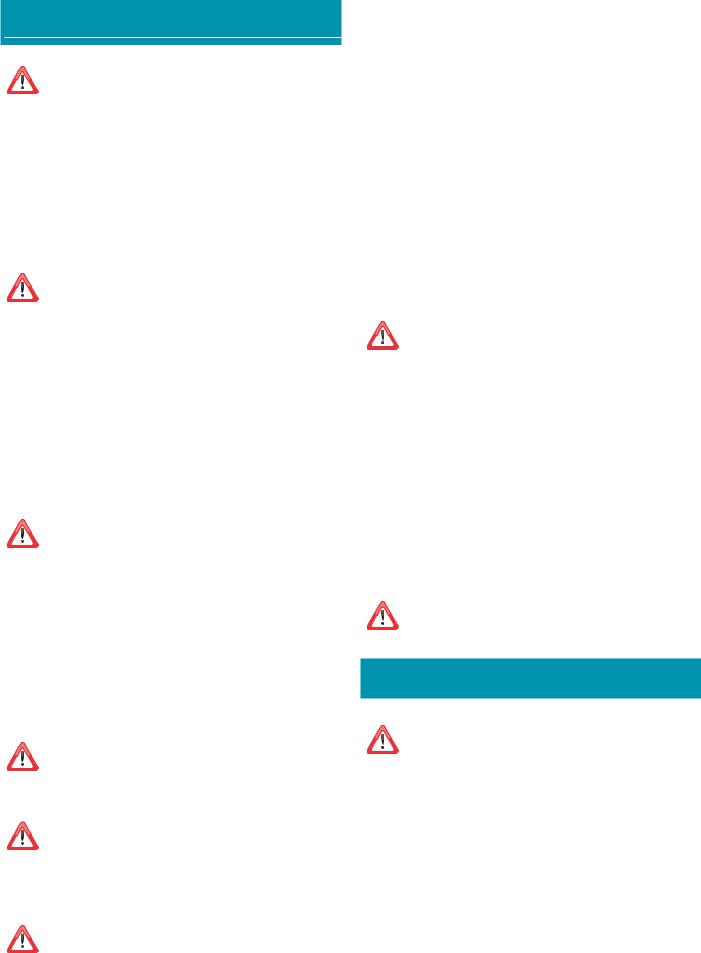
SAFETY INSTRUCTIONS
AND WARNINGS
Installation operations are to be carried out by skilled and qualiied installers in accordance with the instructions in this booklet and in compliance with the regulations in force.
DO NOT use the hood if the power supply cable or other components are damaged: disconnect the hood from the electrical power supply and contact the Dealer or an authorised Servicing Dealer for repairs.
Do not modify the electrical, mechanical or functional structure of the equipment.
Do not personally try to carry out repairs or replacements. Interventions carried out by incompetent and unauthorised persons can cause serious damage to the unit or physical and personal harm, not covered by the Manufacturer's warranty.
WARNINGS FOR THE INSTALLER
TECHNICAL SAFETY
Before installing the hood, check the integrity and function of each part. Should anomalies be noted, do not proceed with installation and contact the Dealer.
Do NOT install the hood if an aesthetic (or cosmetic) defect has been detected. Put it back into its original package and contact the dealer.
No claim can be made for aesthetic (or cosmetic) defects once it has been installed.
During installation, always use personal protective equipment (e.g.: Safety shoes) and adopt prudent and proper conduct.
The installation kit (screws and plugs) supplied with the hood is only to be used on masonry walls: in case of installation on walls of a diferent material, assess other installation options keeping in mind the type of wall surface and the weight of the hood (indicated on page 2).
Keep in mind that installations with diferent types of fastening systems from those supplied, or which are not compliant, can cause electrical and mechanical seal danger.
Do not install the hood outdoors and do not expose it to atmospheric elements (rain, wind, etc.).
ELECTRICAL SAFETY
The electrical system to which the hood is to be connected must be in accordance with local standards and supplied with earthed connection in compliance with safety regulations in the country of use. It must also comply with European standards regarding radio antistatic properties.
Before installing the hood, check that the electrical mains power supply corresponds with what is reported on the identiication plate located inside the hood.
The socket used to connect the installed equipment to the electrical power supply must be within reach: otherwise, install a mains switch to disconnect the hood when required.
Any changes to the electrical system must be carried out by a qualiied electrician.
The maximum length of the lue fastening screws (supplied by the manufacturer) must be 13 mm. Use of non-compliant screws with these instructions can lead to danger of an electrical nature.
Do not try to solve the problem yourself in the event of equipment malfunction, but contact the Dealer or an authorised Servicing Department for repairs.
When installing the hood, disconnect the equipment by removing the plug or switching of the main switch.
FUMES DISCHARGE SAFETY
Do no connect the equipment to discharge pipes of fumes produced from combustion (for example boilers, ireplaces, etc.).
Before installing the hood, ensure that all standards in force regarding discharge of air out of the room have been complied with.
USER WARNINGS
These warnings have been drawn up for your personal safety and those of others. You are therefore kindly asked to read the booklet carefully in its entirety before using the or cleaning the equipment.
The Manufacturer declines all responsibility for any damage caused directly, or indirectly, to persons, things and pets as a consequence of failing to comply with the safety warnings indicated in this booklet.
It is imperative that this instructions booklet is kept together with the equipment for any future consultation.
If the equipment is sold or transferred to another person, make sure that the booklet is also supplied so that the new user can be made aware of the hood's operation and relative warnings.
After the stainless steel hood has been installed, it will need to be cleaned to remove any residues remaining from the protection adhesive as well as any grease and oil stains which, if not removed, can cause irreversible damage to the hood surface. To properly clean the unit, the manufacturer recommends using the supplied moist wipes, which are also available sold separately.
Insist on original spare parts.
INTENDED USE
The equipment is solely intended to be used to extract fumes generated from cooking food in non-professional domestic kitchens: any other use is improper. Improper use can cause damage to persons, things, pets and exempts the Manufacturer from any liability.
The equipment can be used by children over the age of 8 and by persons with reduced physical, sensory and mental abilities, or with no experience or knowledge, as long as they do so under supervision or after having received relative instructions regarding safe use of the equipment and understanding of the dangers connected to it.
Children are not to play with the equipment. Cleaning and maintenance by the user must not be carried out by children without supervision.
CLEANING WARNINGS
Before cleaning or carrying out maintenance operations, disconnect the equipment by removing the plug or switching of the main switch.
Do not use the hood with wet hands or bare feet.
Always check that all electrical parts (lights, extractor fan) are of when the equipment is not being used.
The maximum overall weight of any objects placed or hung (if applicable) on the hood must not exceed 1.5 Kg.
Always supervise the cooking process during the use of deep-fryers: Overheated oil can catch ire.
Do not leave open, unattended lames under the hood. Do not prepare food over an open lame under the hood.
Never use the hood without the metal anti-grease ilters: in this case, grease and dirt will deposit in the equipment and compromise its operation.
Accessible parts of the hood can be hot when used at the same time as the cooking appliances.
Do not carry out any cleaning operations when parts of the hood are still hot.
There can be a risk of ire if cleaning is not carried out according to the instructions and products indicated in this booklet.
Disconnect the main switch when the equipment is not used for long periods of time.
If other appliances that use gas or other fuels are being used at the same time (boiler, stove, ireplaces, etc.), make sure the room where the fumes are discharged is well-ventilated, in compliance with the local regulations.
INSTALLATION
only intended for qualiied personnel
Before installing the hood, carefully read the chapter 'SAFETY INSTRUCTIONS AND WARNINGS'.
TECHNICAL FEATURES
The technical speciications are exhibited on the labels located inside the hood.
POSITIONING
The minimum distance between the highest part of the cooking equipment and the lowest part of the hood is indicated in the installation instructions.
Generally, when the hood is placed over gas cookers, the distance must be at least 65 cm (25.6''). However, according to an interpretation of standard EN60335-2-31 dated 11-07- 2002 of TC61 (sub-clause 7.12.1 meeting 15 agenda item 10.11), the minimum distance between the cooker and lower part of the hood can be reduced to the quota reported in the installation instructions.
Should the instructions for the gas cooker specify a greater distance, this must be taken into consideration.
Do not install the hood outdoors and do not expose it to outdoor environment (rain, wind, etc.).
14
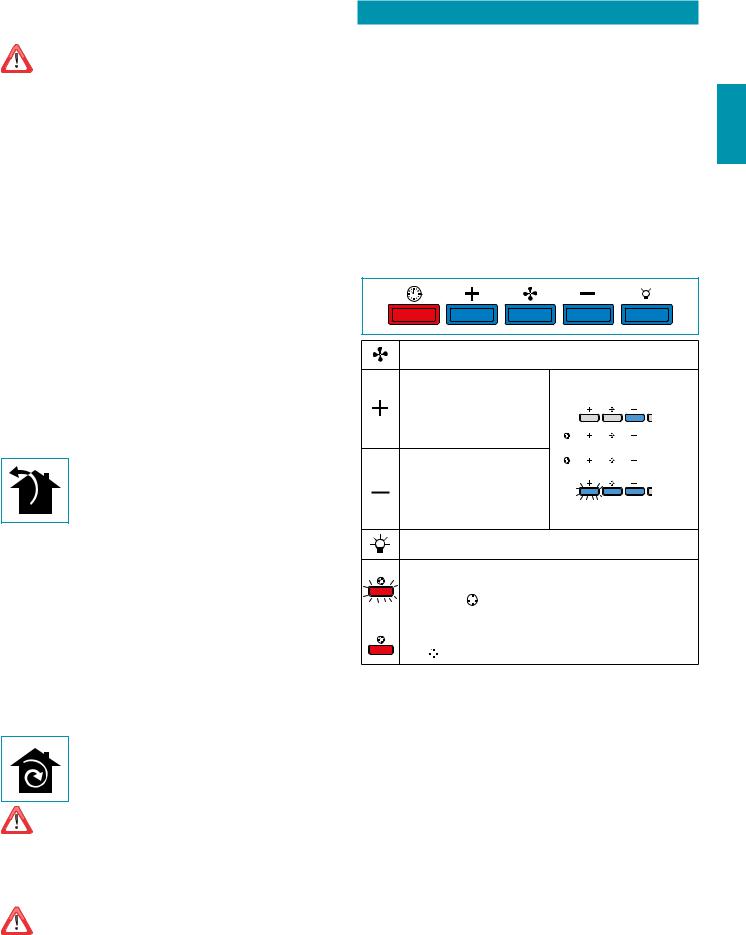
ELECTRICAL CONNECTION
(only intended for qualiied personnel)
Disconnect the equipment from electrical mains power supply before carrying out any operations on the hood.
Ensure that the wires inside the hood are not disconnected or cut: in the event of damage, contact your nearest Servicing Department.
Refer to qualiied personnel for electrical connections.
Connection must be carried out in compliance with the provisions of law in force.
Before connecting the hood to the electrical mains power supply, check that:
Пvoltage supply corresponds with what is reported on the data plate located inside the hood;
Пthe electrical system is compliant and can withstand the load (see the technical speciications located inside the hood);
Пthe power supply plug and cable do not come into contact with temperatures exceeding 70 °C;
Пthe power supply system is efectively and properly connected to earth in compliance with regulations in force;
Пthe socket used to connect the hood is within reach.
In case of:
Пdevices itted with cables without a plug: the type of plug to use is a ''standardised'' one.
The wires must be connected as follows: yellow-green for earthing, blue for neutral and brown for the phase. The plug must be connected to an adequate safety socket.
Пixed equipment not provided with a power supply cable and plug, or any other device that ensures disconnection from the electrical mains, with an opening gap of the contacts that enables total disconnection in overvoltage category III conditions.
Said disconnection devices must be provided in the mains power supply in compliance with installation regulations.
The yellow/green earth cable must not be cut of by the switch.
The Manufacturer declines all responsibility for failure to comply with the safety regulations.
FUMES DISCHARGE
EXTERNAL EXHAUST HOOD (SUCTION)
In this version the fumes and vapours are discharged outside through the exhaust pipe.
To this end, the hood outlet itting must be connected via a pipe, to an external output.
The outlet pipe must have:
Пa diameter not less than that of the hood itting.
Пa slight slope downwards (drop) in the horizontal sections to prevent condensation from lowing back into the motor.
Пthe minimum required number of bends.
Пthe minimum required length to avoid vibrations and reduce the suction performance of the hood.
You are required to insulate the pipes if it passes through cold environments.
In the presence of motors with 800m3/h or higher, a check valve is present to prevent external air lowing back.
Deviation for Germany:
when the kitchen hood is used at the same time as appliances that are powered by energy other than electricity, the negative pressure in the room must not exceed 4 Pa (4 x 10-5 bar).
HOOD WITH INTERNAL RECIRCULATION (FILTERING)
In this model, the air passes through the charcoal ilters to be puriied and recycled in the environment.
Ensure that the active carbon ilters are assembled into the hood, if not, install them as indicated in the assembly instructions.
In this version the check valve must not be assembled: remove it if it is on the air outlet itting of the motor.
ASSEMBLY INSTRUCTIONS
only intended for qualiied personnel
The hood can be installed in various conigurations.
The generic assembly steps apply to all installations; for each case, follow the speciic steps provided for the required installation.
OPERATION
WHEN TO TURN ON THE HOOD?
Switch on the hood at least one minute before starting to cook to direct fumes and vapours towards the suction surface.
After cooking, leave the hood operating until complete extraction of all vapours and odours. By means of the Timer function, it is possible to set auto switch-of function which will allow the hood to turn of automatically after 15 minutes of operation.
WHICH SPEED IS TO BE SELECTED?
1st speed: maintains the circulation of clean air with low electricity consumption. 2nd speed: normal conditions of use.
3rd speed: presence of strong odours and vapours. 4th speed: rapid disposal of odours and vapours.
WHEN SHOULD THE FILTERS BE WASHED OR REPLACED?
The metal ilters must be cleaned every 30 hours of operation.
The active carbon ilters must be replaced every 3-4 months, depending on the use of the hood.
For further details see the “MAINTENANCE” chap.
ELECTRONIC PUSHBUTTON PANEL (GRUPPO INCASSO, A+)
Motor ON/OFF
Upon start-up, the speed is that stored at the previous operation.
Increase speed from 1 to 4
Speed 4 is only active for a few minutes, then speed 3 activates.
Reduce speed from 4 to 1
The speeds are indicated by the LEDs on the keys:
 Speed 1
Speed 1




 Speed 2
Speed 2




 Speed 3
Speed 3
 Speed 4
Speed 4
("+" LED lashing)
Light on/of
TIMER (red LED lashing)
Auto switch-of after 15 min.
The function deactivates (red LED of ) if:
-The TIMER key ( 
 ) is pressed again.
) is pressed again.
-The ON/OFF key ( ) is pressed.
) is pressed.
FILTER ALARM (red LED steady on with ( ) of)
) of)
Anti-grease ilter maintenance after approximately 30 hours of operation. Press ( ) the meter for 3 seconds to reset.
) the meter for 3 seconds to reset.
<![endif]>ENGLISH
15
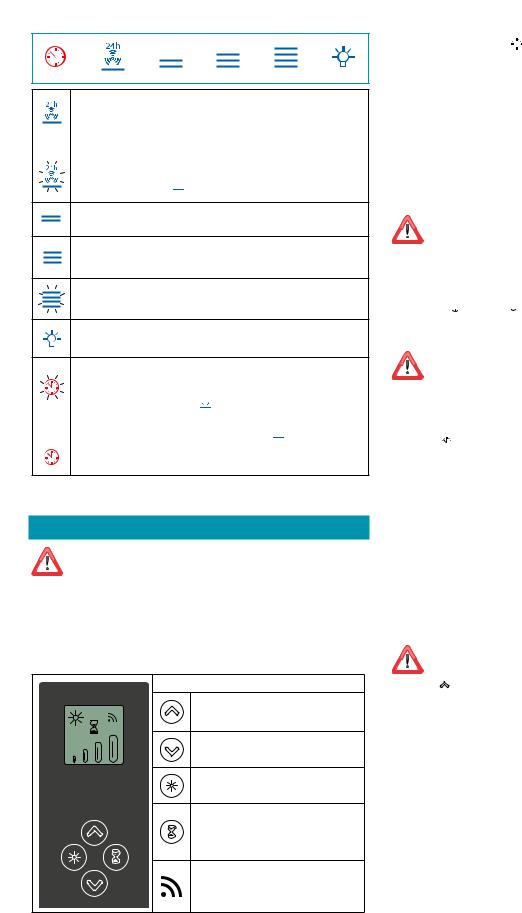
TOUCH PUSHBUTTON PANEL (GRUPPO INCASSO MURANO)
ON/OFF (Blue led steady on)
Motor on/of and Speed 1
ON/OFF (blue led lashing)
If pressed for more than 3 seconds, it activates the 24h cycle (1h ON -> 3h OFF -> 1h ON)
the function deactivates if:
- The motor turns of (key 
 ) - After 24h
) - After 24h
Speed 2 activation
Speed 3 activation
Speed 4 is only active for a few minutes, then speed 3 activates.
Light on/of
TIMER (red LED lashing) Auto switch-of after 15 min.
The function deactivates (red LED of ) if: - The motor turns of (key 
 ).
).
- The speed is changed.
FILTER ALARM (red LED steady on with ( 
 ) of ) Anti-grease ilter maintenance after approximately 30 hours of operation.
) of ) Anti-grease ilter maintenance after approximately 30 hours of operation.
Press the meter for 3 seconds to reset.
USING THE RADIO CONTROL
WARNINGS!:
Place the hood away from sources of electromagnetic waves (e.g. microwave ovens), which could interfere with the radio control and with the hood
electronics.
The maximum operating distance is 5 metres, that may vary according to the presence of electromagnetic interferences.
Radio control operated at 433.92MHz. The radio control consists of two parts:
-the receiver built into the hood;
-the transmitter shown here in the igure.
DESCRIPTION OF TRANSMITTING COMMANDS
UP
Motor switch-on and speed increase from 1 to 4. Speed 4 is only active for a few minutes.
DOWN
Speed decrease and motor switch-of.
Light ON-OFF
TIMER ON: The motor automatically switches of after 15 min.
The function is automatically disabled if the motor is switched of ( key)
key)
Command transmission active
The radio control is optional for the GRUPPO INCASSO and A+.
Follow the entire procedure described below if purchased.
Skip the activation procedure for IL GRUPPO INCASSO MURANO.
ACTIVATION PROCEDURE (for GRUPPO INCASSO and A+)
Before using the radio control, follow the procedure below on the hood pushbutton panel:
•Press LIGHT ( ) and TIMER (
) and TIMER ( ) simultaneously until all LEDs start lashing.
) simultaneously until all LEDs start lashing.
•Release the two keys and press LIGHT ( ) again until all LEDs are lit up.
) again until all LEDs are lit up.
•Release LIGHT ( ): now the receiver is active.
): now the receiver is active.
This procedure is also used to deactivate the receiver.
RADIO CONTROL CODE CHANGE
With only one radio control, go directly to point 2.
With several radio controls in the same room, a new code can be created by following the procedure below.
Disconnect the power to the hood before starting the procedure.
1) - CREATE A NEW CODE
The procedure is to be carried out on the radio control.
•Press LIGHT  and TIMER
and TIMER  simultaneously until the display starts lashing.
simultaneously until the display starts lashing.
•Press DOWN  on the radio control: saving is conirmed by three brief lashes of the display. The new code cancels and replaces the previous default code.
on the radio control: saving is conirmed by three brief lashes of the display. The new code cancels and replaces the previous default code.
Reconnect the hood to the electrical power supply, making sure that the lights and motor are of.
2A) - ASSOCIATING THE RADIO CONTROL WITH THE HOOD USING THE ELECTRONIC PUSHBUTTON PANEL
press TIMER ( ) on the hood pushbutton panel for 2 seconds: the red LED lights up.
) on the hood pushbutton panel for 2 seconds: the red LED lights up.
press any key on the radio control within 10 seconds.
2B) - ASSOCIATING THE RADIO CONTROL WITH THE HOOD USING THE TOUCH PUSHBUTTON PANEL
press LIGHT ( ) on the hood pushbutton panel for 2 seconds: the red LED lights up.
) on the hood pushbutton panel for 2 seconds: the red LED lights up.
press any key on the radio control within 10 seconds.
RESTORING DEFAULT CODE
the procedure is to be carried out if the hood is disposed of, sold or transferred.
Disconnect the power to the hood before starting the procedure.
•Press UP  and DOWN
and DOWN  simultaneously on the radio control for more than 5 seconds: reset is conirmed by three brief lashes of the display.
simultaneously on the radio control for more than 5 seconds: reset is conirmed by three brief lashes of the display.
•Reconnect the hood to the electrical power supply.
•Proceed with associating the hood and the radio control, as described in point 2.
16
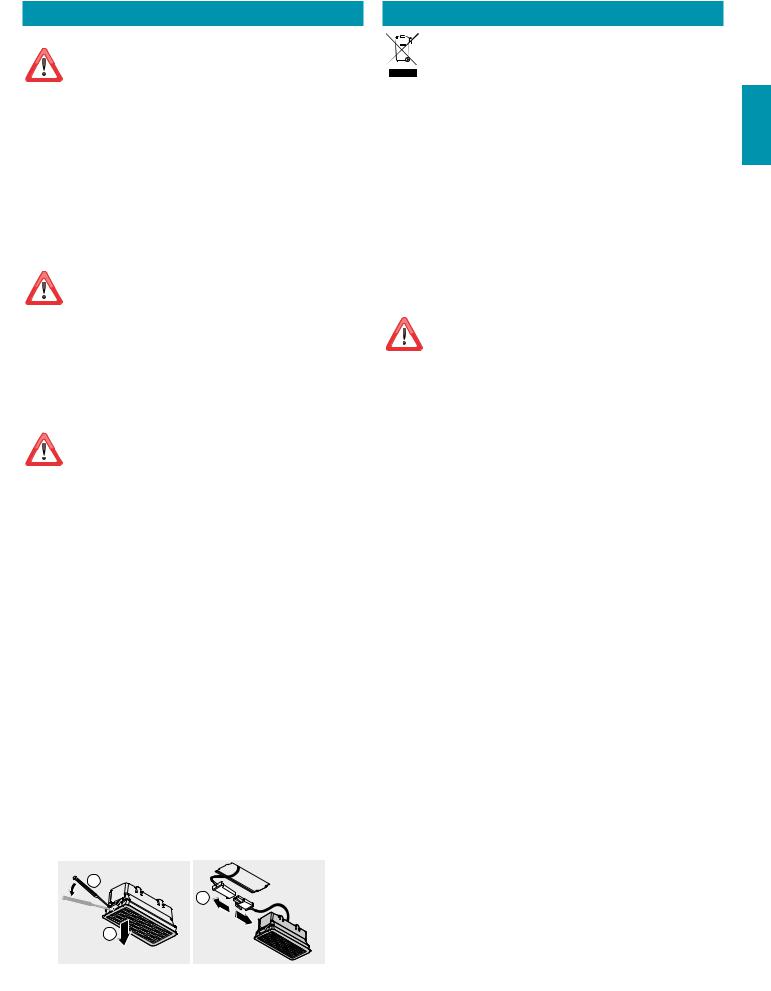
MAINTENANCE |
AFTER END OF USEFUL LIFE |
Before cleaning or carrying out maintenance operations, disconnect the equipment by removing the plug or switching of the main switch.
Do not use detergents containing abrasive, acidic or corrosive substances or abrasive cloths.
Regular maintenance guarantees proper operation and performance over time.
Special attention is to be paid to the metal anti-grease ilters : frequent cleaning of the ilters and their supports ensures that no lammable grease is accumulated.
CLEANING OF EXTERNAL SURFACES
You are advised to clean the external surfaces of the hood at least once every 15 days to prevent oily substances and grease from sticking to them. To clean the brushed stainless steel hood, the Manufacturer recommends using "Magic Steel" wipes.
Alternatively and for all the other types of surfaces, it can be cleaned using a damp cloth, slightly moistened with mild, liquid detergent or denatured alcohol.
cleaning by rinsing well and drying with soft cloths.
Do not use too much moisture or water around the push button control panel and lighting devices in order to prevent humidity from reaching electronic parts.
The glass panels can only be cleaned with speciic, non-corrosive or non-abrasive deter gents using a soft cloth.
The Manufacturer declines all responsibility for failure to comply with these instructions.
CLEANING OF INTERNAL SURFACES
Do not clean electrical parts, or parts related to the motor inside the hood, with liquids or solvents.
For the internal metal parts, see the previous paragraph.
METAL ANTI-GREASE FILTERS
It is advised to frequently wash the metal ilters (at least once a month) leaving them to soak in boiling water and cleaning solution for 1 hour, taking care not to bend them.
Do not use corrosive, acid or alkaline detergents.
Rinse them well and wait for them to be completely dry before reassembling them. Washing in a dishwasher is permitted, however, it may cause the ilter material to darken: to reduce the possibility of this problem from happening, use low-temperature washes (55°C max.).
To extract and insert the metal anti-grease ilters see the assembly instructions.
The crossed-out trash or refuse bin symbol on the appliance means that the product is WEEE, i.e. “Waste electrical and electronic equipment'', accordingly it must not be disposed of with regular unsorted waste (i.e. with ''mixed household waste''), but it must be disposed of separately so that it can undergo specif-
ic processing for its re-use, or a speciic treatment, to remove and safely dispose of any substances that may be harmful to the environment and remove the raw materials that can be recycled. Proper disposal of these products contributes to saving valuable resources and avoid potential negative efects on personal health and the environment, which may be caused by inappropriate disposal of waste.
You are kindly asked to contact your local authorities for further information regarding the designated waste collection points nearest to you. Penalties for improper disposal of such waste can be applied in compliance with national regulations.
INFORMATION ON DISPOSAL IN EUROPEAN UNION COUNTRIES
The EU WEEE Directive was implemented diferently in each country, accordingly, if you wish to dispose of this appliance we suggest contacting your local authorities or dealer to ind out what the correct method of disposal is.
INFORMATION ON DISPOSAL IN NON-EUROPEAN UNION COUNTRIES
The crossed-out trash or refuse bin symbol is only valid in the European Union: if you wish to dispose of this appliance in other countries, we suggest contacting your local authorities or dealer to ind out what the correct method of disposal is.
WARNING!
The Manufacturer reserves the right to make changes to the equipment at any time and without prior notice. Printing, translation and reproduction, even partial, of this manual are bound by the Manufacturer's authorisation.
Technical information, graphic representations and speciications in this manual are for information purposes and cannot be divulged.
This manual is written in Italian. The Manufacturer is not responsible for any transcription or translation errors.
<![endif]>ENGLISH
ACTIVE CARBON FILTERS
These ilters retain the odours in the air that passes through them. The puriied air is recirculated into the environment.
The active carbon ilters must be replaced on average every 3-4 months under normal conditions of use.
See assembly instructions to replace the active carbon ilters.
LIGHTING
The range hood is equipped with high eiciency, low consumption LED spotlights with an extremely long life-span under normal use conditions.
Should the LED spotlight need to be as shown in the igure.
1
3
2 |
12V |
|
17
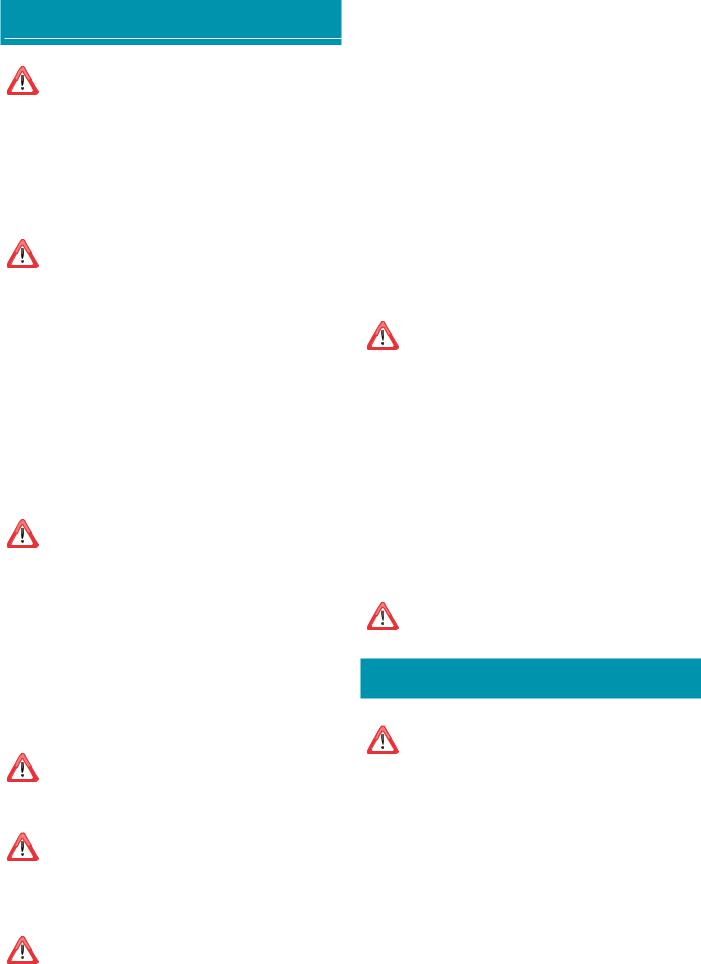
ANWEISUNGEN FÜR DIE SICHERHEIT
UND WARNHINWEISE
Die Installation muss von kompetenten und qualiizierten Installateuren unter Befolgung der Angaben der vorliegenden Gebrauchsanweisung sowie unter Einhaltung der gültigen Sicherheitsvorschriften vorgenommen werden.
Wenn das Versorgungskabel oder andere Komponenten beschädigt sind, darf die Abzugshaube NICHT verwendet werden: Die Abzugshaube von der Stromversorgung trennen und den Händler oder den autorisierten Kundendienst für die Reparatur kontaktieren.
Die elektrische, mechanische und funktionelle Struktur des Geräts darf nicht verändert werden.
Niemals versuchen, Reparaturen oder Austauschtätigkeiten selbst durchzuführen. Werden diese Arbeiten von Personen durchgeführt, die nicht dazu befähigt und qualiiziert sind, so kann dies zu schweren Personenund Sachschäden führen, die von der Herstellergarantie nicht gedeckt sind.
HINWEISE FÜR DEN INSTALLATEUR
TECHNISCHE SICHERHEIT
Vor der Installation der Abzugshaube muss sichergestellt werden, dass sämtliche Komponenten unbeschädigt und funktionstüchtig sind. Sollten Schäden festgestellt werden, nicht mit der Installation fortfahren und umgehend den Händler kontaktieren.
Sollte ein ästhetischer Mangel festgestellt werden, so darf die Abzugshaube NICHT installiert werden. Die Abzugshaube wieder verpacken und umgehend den Händler kontaktieren.
Sobald die Abzugshaube installiert ist, werden keine Beanstandungen aufgrund ästhetischer Mängel mehr akzeptiert.
Während der Installation ist immer eine geeignete persönliche Schutzausrüstung zu tragen (z.B. Si cherheitsschuhwerk) und aufmerksam und korrekt vorzugehen.
Das mit der Abzugshaube gelieferte Befestigungsset (Schrauben und Dübel) darf ausschließlich für gemauerte Wände verwendet werden. Sollte es notwendig sein, die Abzugshaube an einer Wand aus anderem Material zu installieren, müssen alternative Befestigungssysteme in Betracht gezogen werden, wobei die Festigkeit der Wand und das Gewicht der Abzugshaube (siehe S. 2) zu berücksichtigen sind.
Dabei ist zu beachten, dass die Installation mit Befestigungssystemen, die von den mitgelieferten abweichen, elektrische Gefahren und Risiken in Bezug auf die mechanische Abdichtung mit sich bringen kann.
Die Abzugshaube darf nicht in Außenbereichen installiert und keinen Witterungseinlüssen (Regen, Wind, etc.) ausgesetzt werden.
ELEKTRISCHE SICHERHEIT
Die elektrische Anlage für den Anschluss der Abzugshaube muss den geltenden Normen entsprechen und mit einem Erdungssystem ausgestattet sein, das den Sicherheitsvorschriften des Installationslandes entspricht. Sie muss außerdem der EU-Gesetzgebung bezüglich der Funkentstörung entsprechen.
Vor der Installation der Abzugshaube muss überprüft werden, dass die Netzspannung derjenigen auf dem Typenschild im Inneren der Abzugshaube entspricht.
Die für den elektrischen Anschluss verwendete Steckdose muss gut erreichbar sein, wenn das Gerät installiert ist Andernfalls muss ein Hauptschalter vorgesehen werden, um die Abzugshaube bei Bedarf zu trennen.
Sämtliche eventuellen Änderungen an der Elektroanlage müssen von einem qualiizierten Elektriker vorgenommen werden.
Die Mindestlänge der Befestigungsschraube des Kamins (vom Hersteller mitgeliefert) beträgt 13 mm. Die Verwendung von Schrauben, die der vorliegenden Gebrauchsanweisung nicht entsprechen, kann elektrische Gefahren mit sich bringen.
Im Fall einer Störung des Geräts nicht versuchen, das Problem eigenständig zu lösen, sondern den Händler oder den autorisierten Kundendienst für die Reparatur kontaktieren.
Während der Installation der Abzugshaube muss das Gerät durch Ziehen des Netzsteckers oder Betätigung des Hauptschalters abgeschaltet werden.
SICHERHEIT RAUCHABZUG
Das Gerät nicht an Rohre für den Abzug von Rauch anschließen, der durch Verbrennung entsteht (z.B. Heizkessel, Kamine, etc.).
Vor der Installation der Abzugshaube muss sichergestellt werden, dass alle gültigen gesetzlichen Vorschriften in Bezug auf die Luftableitung aus dem Raum eingehalten werden.
HINWEISE FÜR DEN BENUTZER
Diese Hinweise wurden für Ihre Sicherheit und die Sicherheit anderer Personen erstellt, und wir bitten Sie deshalb, die vorliegende Gebrauchsanweisung vor der Installation, der Verwendung oder der Reinigung des Geräts vollständig zu lesen.
Der Hersteller lehnt jegliche Haftung für etwaige direkte oder indirekte Schäden von Personen, Gegenständen oder Haustieren ab, die durch eine Nichtbeachtung der in der vorliegenden Gebrauchsanweisung angeführten Sicherheitshinweise verursacht werden.
Es ist sehr wichtig, dass diese Gebrauchsanweisung zusammen mit dem Gerät aufbewahrt wird, damit künftig darin nachgelesen werden kann.
Falls das Gerät verkauft oder an eine andere Person übergeben wird, muss sichergestellt werden, dass auch die Gebrauchsanweisung übergeben wird, damit der neue Besitzer informiert werden kann, wie die Abzugshaube funktioniert und welche diesbezüglichen Warnhinweise zu beachten sind.
Nach der Installation der Edelstahlhaube muss als Erstes deren Reinigung erfolgen, um die Rückstände der Schutzklebefolie und eventuelle Flecken von Öl oder Fett zu entfernen, die die Oberläche der Abzugshaube unwiderrulich beschädigen können, falls sie nicht entfernt werden. Für diesen Vorgang empiehlt der Hersteller, die mitgelieferten Reinigungstücher zu benutzen, die auch gekauft werden können.
Immer die Verwendung von originalen Ersatzteilen fordern.
VERWENDUNGSBESTIMMUNG
Das Gerät ist ausschließlich für die Absaugung von Rauch bestimmt, der während der Zubereitung von Speisen in Haushaltsküchen, nicht in gewerblichen Küchen, erzeugt wird. Jede andere Verwendung gilt als unsachgemäß, kann Schäden an Personen, Gegenständen und Haustieren verursachen und enthebt den Hersteller von jeglicher Verantwortung.
Dieses Gerät kann von Kindern ab 8 Jahren sowie von Personen mit reduzierten physischen, sensorischen oder mentalen Fähigkeiten oder Mangel an Erfahrung und/oder Wissen benutzt werden, wenn sie beaufsichtigt oder bezüglich des sicheren Gebrauchs des Gerätes unterwiesen wurden und die damit zusammenhängenden Gefahren verstanden haben.
Kinder dürfen nicht mit dem Gerät spielen. Kinder dürfen die vom Benutzer auszuführende Reinigung und Wartung nicht unbeaufsichtigt durchführen.
HINWEISE FÜR VERWENDUNG UND REINIGUNG
Vor jedem Reinigungsoder Wartungseingrif das Gerät durch Ziehen des Netzsteckers oder Betätigung des Hauptschalters vom Stromnetz trennen.
Die Abzugshaube nicht mit nassen Händen oder nackten Füßen verwenden.
Immer kontrollieren, dass alle elektrischen Teile (Beleuchtung, Absauganlage) ausgeschaltet sind, wenn das Gerät nicht verwendet wird.
Das maximale Gesamtgewicht eventuell auf der Abzugshaube abgestellter oder an ihr aufgehängter Gegenstände (falls vorgesehen) darf 1,5 kg nicht überschreiten.
Fritteusen müssen während des Betriebs überwacht werden: Das erhitzte Öl könnte Feuer fangen. Unter der Haube keine ofenen Flammen verwenden.
Unterhalb der Abzugshaube keine Garvorgänge mit "ofenen" Flammen ausführen.
Die Abzugshaube nie ohne Metallfettilter verwenden. In diesem Fall würden sich Fett und Schmutz auf dem Gerät absetzen und seine Funktionstüchtigkeit beeinträchtigen.
Die erreichbaren Teile der Abzugshaube können heiß sein, wenn sie zusammen mit Kochgeräten verwendet werden.
Mit der Reinigung so lange warten, bis alle Teile der Abzugshaube abgekühlt sind.
Sollte die Reinigung nicht gemäß den Vorschriften und mit den Produkten ausgeführt werden, die im vorliegenden Handbuch angegeben sind, so besteht Brandgefahr.
Wenn das Gerät über einen längeren Zeitraum nicht verwendet wird, muss der Hauptschalter abge-
.
Bei gleichzeitiger Verwendung anderer mit Gas oder anderen Brennstofen gespeister Verbraucher (Heizkessel, Öfen, Kamine, etc.) für eine angemessene, vorschriftsmäßige Lüftung des Raumes sorgen, in dem die Dunstabsaugung erfolgt.
INSTALLATION
Dieser Abschnitt ist ausschließlich qualiiziertem Personal vorbehalten
Vor der Installation der Abzugshaube muss das Kapitel "ANWEISUNGEN FÜR DIE SICHERHEIT UND WARNHINWEISE" aufmerksam gelesen werden.
TECHNISCHE MERKMALE
Die technischen Daten des Geräts sind auf den Schildern im Inneren der Abzugshaube angegeben.
POSITIONIERUNG
Der Mindestabstand zwischen dem höchsten Teil des Kochgeräts und dem untersten Teil der Abzugshaube ist in der Montageanleitung angegeben.
Wenn die Abzugshaube über einer Gaskochläche positioniert ist, muss dieser Abstand gewöhnlich mindestens 65 cm (25,6") betragen. Dennoch kann gemäß der Auslegung der Norm EN60335-2-31 vom 11.07.2002 vonseiten der TC61 (subclause 7.12.1 meeting 15 agenda item 10.11) der Mindestabstand zwischen der Kochebene und dem unteren Teil der Abzugshaube auf den in der Montageanleitung angegebenen Wert vermindert werden.
Wenn die Anleitung der Gaskochebene einen größeren Abstand vorschreibt, muss dies eingehalten werden.
Die Abzugshaube darf nicht in Außenbereichen installiert und keinen Witterungseinlüssen (Regen, Wind, etc.) ausgesetzt werden.
18
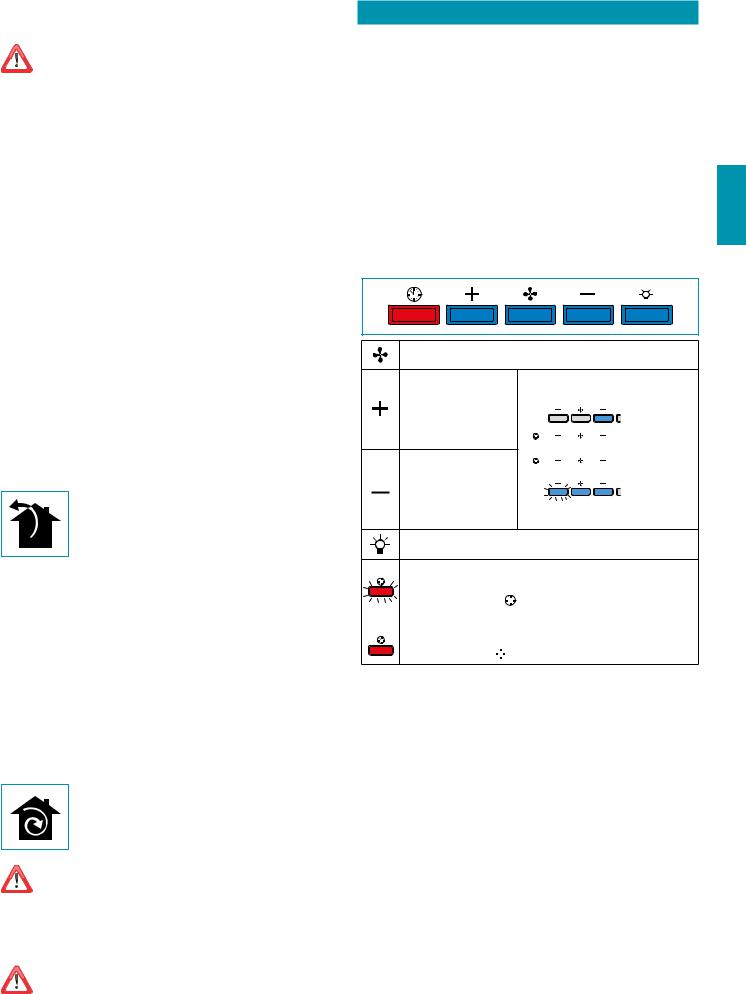
ELEKTRISCHER ANSCHLUSS
(Dieser Abschnitt ist ausschließlich qualiiziertem Personal vorbehalten)
Vor sämtlichen Eingrifen an der Abzugshaube muss das Gerät vom Stromnetz getrennt werden.
Sicherstellen, dass die Elektrokabel in der Abzugshaube nicht abgeschnitten oder getrennt werden:
Andernfalls muss das nächstgelegene Kundendienstzentrum kontaktiert werden. Für die elektrischen Anschlüsse qualiiziertes Personal beauftragen.
Der Anschluss muss in Übereinstimmung mit der geltenden Gesetzgebung ausgeführt werden.
Bevor das Gerät ans Stromnetz angeschlossen wird, muss geprüft werden, dass:
Пdie Netzspannung jener der Daten auf dem Typenschild in der Abzugshaube entspricht;
Пdie elektrische Anlage den gesetzlichen Vorschriften entspricht und für die Belastung des Geräts geeignet ist (siehe Kenndaten in der Abzugshaube);
Пder Stecker und das Kabel nicht mit heiвen Komponenten mit Temperaturen über 70 мC in Berührung kommen;
Пdie Versorgungsanlage mit einer wirksamen und gemäв den geltenden Normen ausgeführten
Erdung verbunden ist;
Пdie für den Anschluss verwendete Steckdose gut erreichbar ist, wenn die Abzugshaube installiert ist.
Bei:
Пmit einem Kabel ohne Stecker ausgestatteten Geräten: muss der zu verwendende Stecker ein genormter Stecker sein. Die Kabel müssen wie folgt angeschlossen werden: Das gelb-grüne Kabel für die Erdung, das blaue Kabel für den Nullleiter und das braune für die Phase. Der Stecker muss an einer geeigneten Sicherheitssteckdose angeschlossen werden.
Пeinem fest montierten Gerät, das über kein Versorgungskabel oder eine andere Vorrichtung zur
Trennung vom Stromnetz mit einer derartigen Öfnungsdistanz der Kontakte verfügt, dass die vollständige Trennung zu den Bedingungen der Überspannungskategorie III erfolgt.
Diese Trennvorrichtungen müssen gemäß den Installationsnormen am Versorgungsnetz installiert werden.
Der grün/gelbe Erdungsdraht darf nicht vom Schalter unterbrochen werden.
Der Hersteller lehnt jede Haftung ab, falls die Sicherheitsnormen nicht eingehalten werden.
RAUCHABZUG
ABZUGSHAUBE IN VERSION AUSSENABLUFT (ABLUFTVERSION)
Bei dieser Ausführung werden die Dämpfe über ein Abzugsrohr nach außen abgeleitet.
Deshalb muss der Anschluss der Haube für den Abzug mit einem Rohr an einem externen Abzug angeschlossen werden.
Das Abzugsrohr muss:
Пeinen gröвeren Durchmesser als der Abzugshaubenanschluss haben.
Пin den horizontalen Abschnitten eine leichte Neigung nach unten aufweisen (Gefälle), um zu verhindern, dass das entstehende Kondenswasser in die Abzugshaube zurückließt.
Пso wenig Kurven wie möglich aufweisen.
Пso kurz wie möglich sein, um Vibrationen zu vermeiden, und um zu verhindern, dass die Abzugsleistung der Haube reduziert wird.
Wenn die Rohrleitung durch kalte Räume verläuft, muss sie isoliert werden.
Um ein Rückströmen der Luft von Außen zu vermeiden, verfügen Abzugshauben mit Motoren zu 800m3/h oder mehr, über ein Rückschlagventil.
Abweichungen für Deutschland:
Wenn die Herdabzugshaube gleichzeitig mit Geräten betrieben wird, die mit einer anderen Energie als elektrischem Strom betrieben werden, darf der negative Druck im Raum 4 Pa nicht überschreiten (4 x 10-5 bar).
ABZUGSHAUBE IN VERSION INNENUMLUFT (FILTRIEREND)
In dieser Ausführung strömt die Luft durch die Aktivkohleilter, wo sie gereinigt wird, und wird anschließend in den Raum zurückgeleitet.
Kontrollieren, dass die Aktivkohleilter in der Abzugshaube angebracht sind, andernfalls müssen sie angebracht werden, wie in der Montageanleitung angeführt.
In dieser Ausführung darf das Rückschlagventil nicht montiert werden. Sollte es dennoch am Anschluss für den Luftabzug des Motors vorhanden sein, muss es entfernt werden.
MONTAGEANLEITUNG
Dieser Abschnitt ist ausschließlich qualiiziertem Personal vorbehalten
Die Abzugshaube kann in verschiedenen Konigurationen installiert werden:
Die allgemeinen Montagephasen gelten für alle Installationen; befolgen Sie dagegen die entsprechenden Phasen der gewünschten Installation, wo dies extra angegeben wird.
BETRIEB
WANN MUSS DIE ABZUGSHAUBE EINGESCHALTET WERDEN?
Die Abzugshaube mindestens eine Minute vor Beginn des Kochvorgangs einschalten. Dadurch wird ein Luftstrom erzeugt, der den Rauch und die Dämpfe zur Absaugläche hin befördert.
Nach Abschluss des Kochvorgangs die Abzugshaube noch so lange laufen lassen, bis alle Dämpfe und Gerüche abgesaugt sind. Es besteht eventuell auch die Möglichkeit, mit Hilfe der Timer-Funktion die automatische Abschaltung der Abzugshaube nach 15 Minuten Betrieb einzustellen.
WELCHE GESCHWINDIGKEITSSTUFE SOLL GEWÄHLT WERDEN? Geschwindigkeit 1: Hält die Luft bei geringem Stromverbrauch rein. Geschwindigkeit 2: Wird für normale Bedingungen verwendet.
Geschwindigkeit 3: Wird bei Vorhandensein von starken Gerüchen oder Dämpfen verwendet. Geschwindigkeit 4: Wird für eine schnelle Beseitigung von Gerüchen oder Dämpfen verwendet.
WANN MÜSSEN DIE FILTER GEREINIGT ODER AUSGETAUSCHT WERDEN?
Die Metallilter müssen jeweils nach 30 Betriebsstunden gereinigt werden.
Die Aktivkohleilter müssen im Durchschnitt alle 3-4 Monate, je nachdem, wie oft die Abzugshaube verwendet wird, ausgetauscht werden.
Für weitere Details siehe Kapitel “WARTUNG”.
ELEKTRONISCHE DRUCKKNOPFTAFEL (GRUPPO INCASSO, A+)
Motor ON/OFF
Der Start erfolgt mit der vor dem Ausschalten gespeicherten Geschwindigkeit.
Erhöhung der Geschwindigkeit von 1 bis 4
Die Geschwindigkeit 4 ist nur für einige Minuten aktiviert, dann wird die Geschwindigkeit 3 aktiviert.
Drosselung der Geschwindigkeit von 4 bis 1
Die Geschwindigkeiten werden von den an den Tasten vorhandenen LEDs signalisiert:
 Geschwindigkeit 1
Geschwindigkeit 1




 Geschwindigkeit 2
Geschwindigkeit 2




 Geschwindigkeit 3
Geschwindigkeit 3
 Geschwindigkeit 4
Geschwindigkeit 4
(LED "+" blinkend)
Einschalten / Ausschalten des Lichts
TIMER (rote blinkende LED) Selbstausschaltung nach 15 Minuten
Die Funktion wird deaktiviert (rote LED ausgeschaltet), wenn:
-man erneut die Taste TIMER ( 
 ) drückt.
) drückt.
-wenn man die Taste ON/OFF ( ) drückt.
) drückt.
ALARM FILTER (rote LED dauerhaft mit ( ) of) Wartung der Fettilter nach ungefähr 30 Betriebsstunden.
) of) Wartung der Fettilter nach ungefähr 30 Betriebsstunden.
3 Sekunden lang drücken ( ), um den Zähler auf Null zu stellen.
), um den Zähler auf Null zu stellen.
<![endif]>DEUTSCH
19
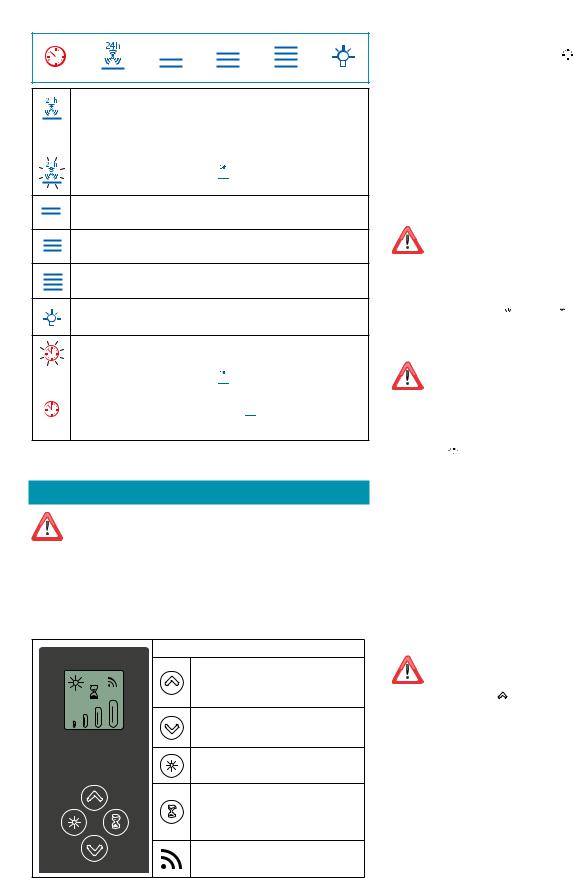
TOUCH-DRUCKKNOPFTAFEL (GRUPPO INCASSO MURANO)
ON/OFF (LED dauerhaft)
Ein-/Ausschaltung des Motors und Vel1.
ON/OFF (blinkende LED)
Bei Druck von mehr als 3 Sekunden aktiviert sich der Betriebszyklus von 24 h (1h ON -> 3h OFF -> 1h ON). Die Funktion wird deaktiviert, wenn:
- Der Motor ausgeschaltet wird (Taste 
 ). - Nach 24h
). - Nach 24h
Aktivierung Geschwindigkeit 2
Aktivierung Geschwindigkeit 3
Aktivierung Geschwindigkeit 4 nur für einige Minuten, dann wird die Geschwindigkeit 3 aktiviert.
Einschalten / Ausschalten des Lichts
TIMER (rote blinkende LED)
Selbstausschaltung nach 15 Minuten
Die Funktion wird deaktiviert (rote LED ausgeschaltet), wenn:
-Der Motor ausgeschaltet wird (Taste 
 ).
).
-Die Geschwindigkeit geändert wird.
ALARM FILTER (rote LED dauerhaft mit ( 
 ) of ) Wartung der Fettilter nach ungefähr 30 Betriebsstunden.
) of ) Wartung der Fettilter nach ungefähr 30 Betriebsstunden.
3 Sekunden lang drücken, um den Zähler auf Null zu stellen.
GEBRAUCH DER FERNBEDIENUNG
VORSICHT!:
Die Abzugshaube nicht in der Nähe von elektromagnetischen Quellen (z.B. Mikrowellenofen) positionieren, welche die Fernbedienung und die Elektronik der Haube
stören könnten.
Der maximale Betriebsabstand beträgt 5 Meter. Diese Entfernung kann sich bei elektromagnetischen Störungen verkürzen.
Die Fernbedienung arbeitet bei 433,92 MHz. Die Fernbedienung besteht aus zwei Teilen:
-dem in der Abzugshaube integrierten Empfänger;
-dem Sender, der hier in der Abbildung dargestellt wird.
BESCHREIBUNG SENDERBEFEHLE
UP
Einschaltung des Motors und Geschwindigkeitserhöhung von 1 bis 4. Die vierte Geschwindigkeit wird nur für einige Minuten aktiviert.
DOWN
Geschwindigkeitsreduktion und Abschaltung des Motors.
Licht ON-OFF
TIMER ON: Automatische Abschaltung des Motors nach 15 Min.
Die Funktion wird automatisch deaktiviert, wenn sich der Motor abschaltet (Taste  )
)
Bedienungsübertragung aktiv
Die Fernbedienung ist für die EINBAUGRUPPE und A+ optional.
Beim Kauf folgen Sie der gesamten nachstehend beschriebenen Vorgehensweise.
Für die EINBAUGRUPPE MURANO überspringen Sie das Aktivierungsverfahren.
AKTIVIERUNGSVERFAHREN (für EINBAUGRUPPE und A+)
Vor Verwendung der Fernbedienung, folgendes Verfahren auf der Druckknopftafel der Abzugshaube ausführen:
•Gleichzeitig die Tasten LICHT ( ) und TIMER (
) und TIMER ( ) drücken, bis alle LED-Lampen zu blinken beginnen.
) drücken, bis alle LED-Lampen zu blinken beginnen.
•Die beiden Tasten freigeben und noch einmal die Taste LICHT ( ) drücken, bis alle LED-Lampen eingeschaltet sind.
) drücken, bis alle LED-Lampen eingeschaltet sind.
•Die Taste LICHT ( ) freigeben: jetzt ist der Empfänger aktiv.
) freigeben: jetzt ist der Empfänger aktiv.
Diese Methode kann auch für die Deaktivierung des Empfängers ausgeführt werden.
ÄNDERUNG DES CODES DER FERNBEDIENUNG
Wenn nur eine Fernbedienung vorhanden ist, direkt zu Punkt 2 weitergehen.
Bei mehreren Fernbedienungen im selben Raum, kann mit der folgenden Methode ein neuer Code erstellt werden.
Die Versorgung für die Abzugshaube vor dem Vorgang trennen.
1) - EINEN NEUEN CODE ERSTELLEN
Das Verfahren wird auf der Fernbedienung ausgeführt.
•Gleichzeitig die Tasten LICHT  und TIMER
und TIMER  drücken, bis das Display zu blinken beginnt.
drücken, bis das Display zu blinken beginnt.
•Die Taste DOWN  der Fernbedienung drücken: der neue Code wird durch 3-maliges kurzes Blinken auf dem Display bestätigt. Der neue Code löscht und ersetzt den alten werkseingestellten Code.
der Fernbedienung drücken: der neue Code wird durch 3-maliges kurzes Blinken auf dem Display bestätigt. Der neue Code löscht und ersetzt den alten werkseingestellten Code.
Die Abzugshaube wieder an das Stromnetz anschließen und prüfen, ob die Lichter und Motoren ausgeschaltet sind.
2A) - VERBINDUNG DER FERNBEDIENUNG MIT DER ABZUGSHAUBE MIT ELEKTRISCHER DRUCKNOPFTAFEL
die Taste TIMER ( ) der Druckknopftafel der Abzugshaube für 2 Sekunden gedrückt halten: die rote LED wird eingeschaltet.
) der Druckknopftafel der Abzugshaube für 2 Sekunden gedrückt halten: die rote LED wird eingeschaltet.
innerhalb von 10 Sekunden irgendeine Taste auf der Fernbedienung betätigen.
2B) - VERBINDUNG DER FERNBEDIENUNG MIT DER ABZUGSHAUBE MIT TOUCH-DRUCKNOPFTAFEL
die Taste LICHT ( ) der Druckknopftafel der Abzugshaube für 2 Sekunden gedrückt halten: die rote LED wird eingeschaltet.
) der Druckknopftafel der Abzugshaube für 2 Sekunden gedrückt halten: die rote LED wird eingeschaltet.
innerhalb von 10 Sekunden irgendeine Taste auf der Fernbedienung betätigen.
WIEDERHERSTELLUNG DES WERKSEINGESTELLTEN CODES
das Verfahren muss bei Weitergabe der Abzugshaube ausgeführt werden.
Die Versorgung für die Abzugshaube vor dem Vorgang trennen.
•Gleichzeitig die Tasten UP  und DOWN
und DOWN  der Fernbedienung für mehr als 5 Sekunden drücken: die erfolgte Wiederherstellung wird durch dreimaliges kurzes Blinken auf dem Display bestätigt.
der Fernbedienung für mehr als 5 Sekunden drücken: die erfolgte Wiederherstellung wird durch dreimaliges kurzes Blinken auf dem Display bestätigt.
•Die Abzugshaube wieder an das Stromnetz anschließen.
•Die Zuordnung von Abzugshaube und Fernbedienung wie in Punkt 2 beschrieben vornehmen.
20
